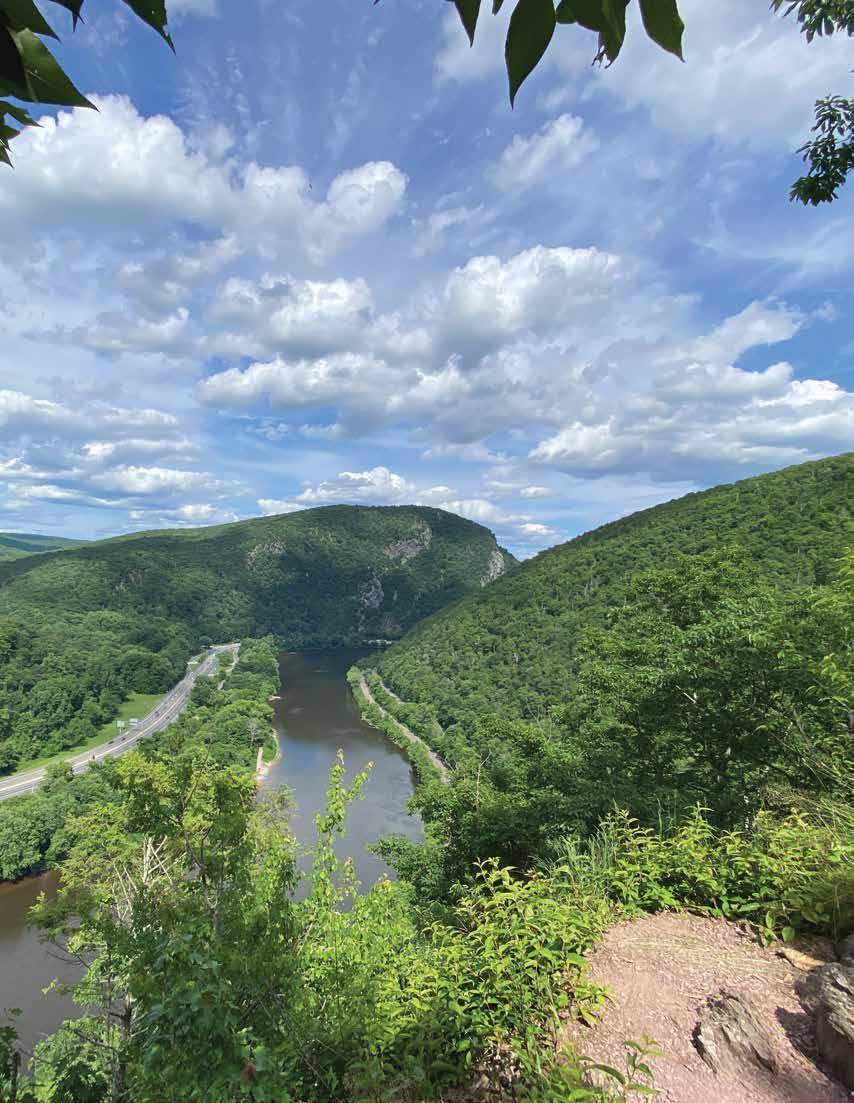
JUNE/JULY 2024 The Pocono Mountains' Magazine Complimentary MAGAZINE Annual Guide to the Delaware Water Gap National Recreation Area




Pocono Living Magazine and Pocono Family Magazine, two regional publications filled with articles, features and photography exploring and capturing the real Pocono Mountains living experience.
Our publications can be found at many locations throughout the Pocono Mountains region, and are available by subscription.
Pocono Magazines, LLC
PUBLISHING
Pocono Living Magazine© & Pocono Family Magazine©
1929 North 5th Street
Stroudsburg, PA 18360
570-424-1000 pmags@ptd.net www.poconomagazines.com
PUBLISHER/EDITOR
Larry R. Sebring
larry@poconomagazines.com
ACCOUNT REPRESENTATIVES
larry@poconomagazines.com
MAGAZINE & WEB DESIGN
Smart Blonde Creative
Food & Wine Editor
Jamie Marra
PHOTOGRAPHY & ART
John Anzivino
Gayle C. Brooke
Ray Caswell
Pat Coyle
Randall FitzGerald
Ashley Hall
Maurice Harmon
Susan Hartman
Marlana Holsten
Ann H. LeFevre
Barbara Lewis
Marie Liu
Harry Loud
Regina Matarazzo
Janet Mishkin
John L. Moore
Michael Murphy
Justine Nearhood
Roseanna Santaniello
Tom Stone
CONTRIBUTING WRITERS
Kimberly Blaker
Roseanne Bottone
Kathy Dubin-Uhler
Sandra Gordon Tanni Haas
Rebecca Hasting
Amanda Kuhn
Amy Leiser
Marie Liu
Sara Lyons
Jamie Marra
Suzanne McCool
Janet Mishkin
John L. Moore
Allison Mowatt
Jim Werkheiser
Kim Williams
Marty Wilson
ADMINISTRATIVE ASSISTANTS
Kristen Sebring
Linda Spalluto
PROUD MEMBERS OF








The information published in this magazine is believed to be accurate, but in some instances, may represent opinion or judgment. The publication’s providers do not guarantee the accuracy or completeness of any information and shall not be held liable for any loss or damage, directly or indirectly, by or from the information.© 2024 Pocono Magazines. All rights reserved. No part of this publication may be copied, reproduced or transmitted in any form or by any means without the expressed written permission of the publisher.


Move beyond the pain with St. Luke’s Orthopedic Care. Let us help you reach your desired level of activity and have a future that’s pain free. Trust St. Luke’s innovative team of orthopedic joint specialists who are skilled in non-operative solutions, robotic-assisted technology, tissue-sparing surgical techniques, and same-day surgery for hips and knees. For Direct Access to St. Luke’s Orthopedic Care, call 484-526-1735. St. Luke’s Orthopedic Care. Start here. Go farther. 1-866-STLUKES • www.sluhn.org With convenient locations throughout the region, including our new St. Luke’s Orthopedic Hospital – West End Campus, the best place for orthopedic care is always close to home. JUNE/JULY 2024 POCONO LIVING MAGAZINE© 3
“Do not follow where the path may lead. Go instead where there is no path and leave a trail.”
― Ralph Waldo Emerson
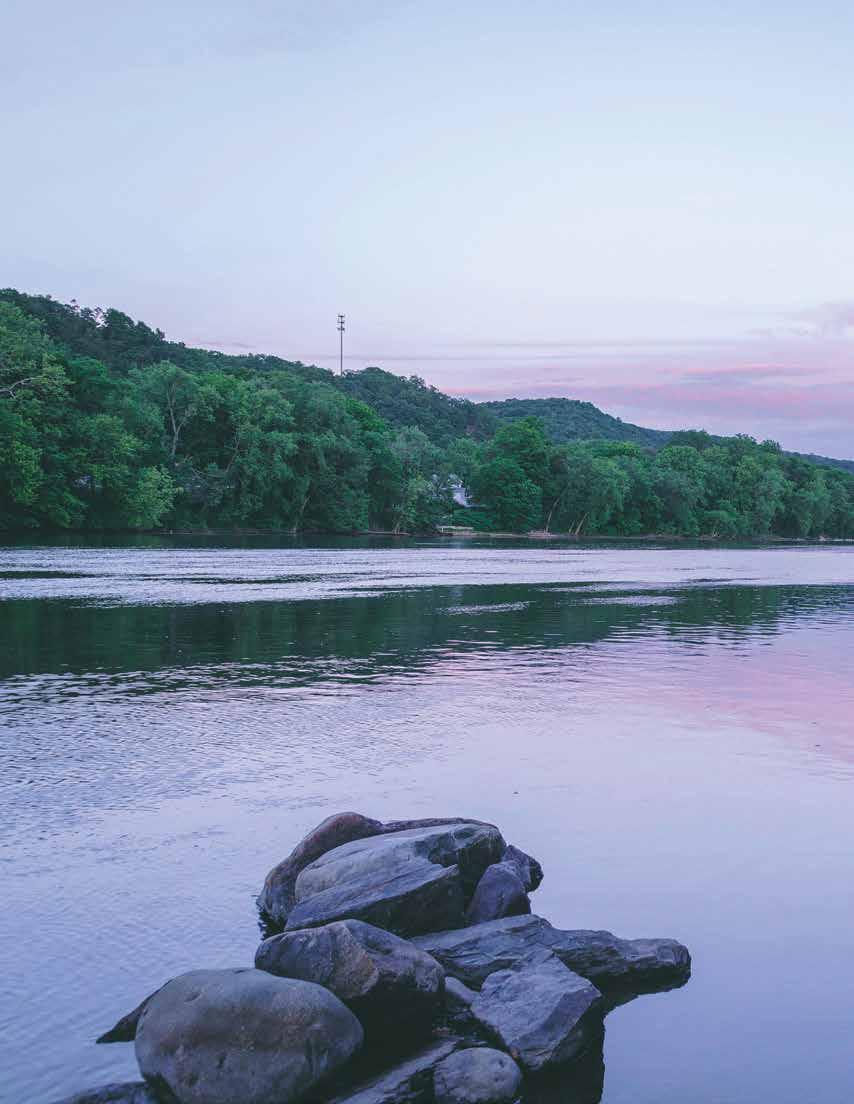
> Photo courtesy of Pexels.com/Craig Adderly
4 POCONO LIVING MAGAZINE © JUNE/JULY 2024

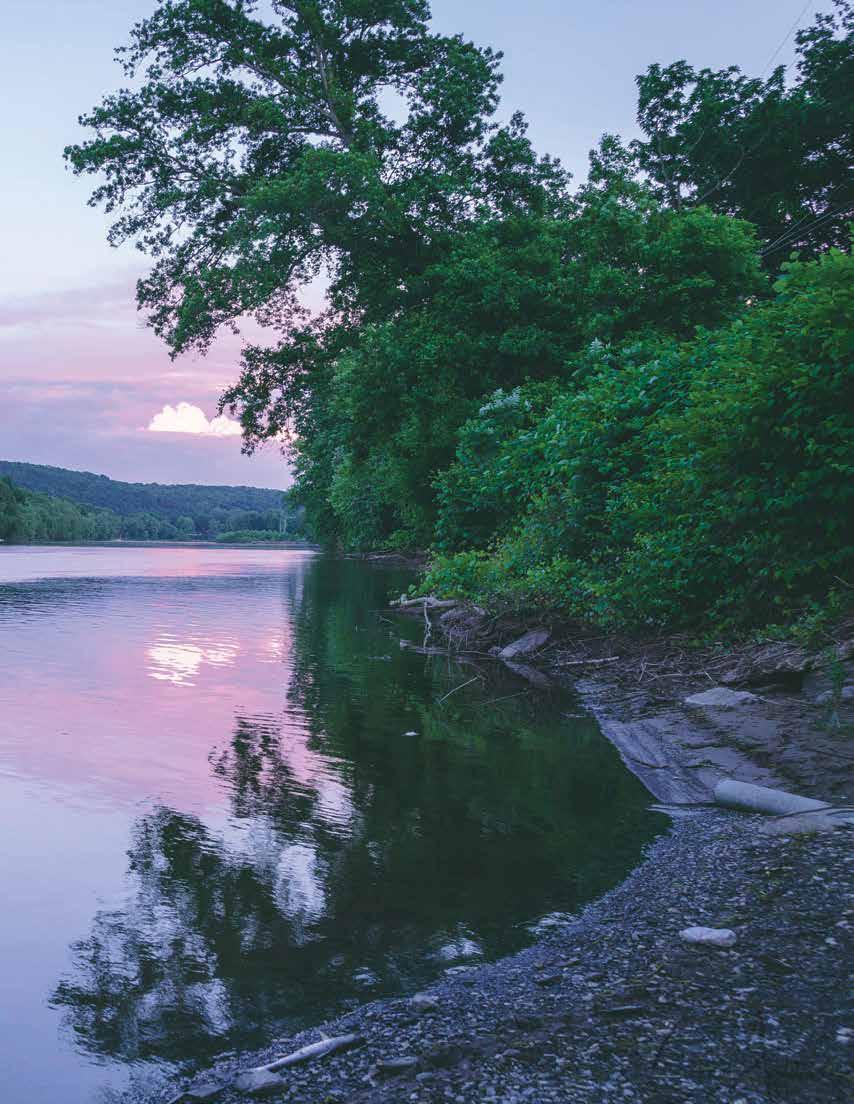
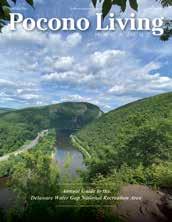
FEATURES What’s Inside June/July 2024 COVER by
6 George Catlin 14 Cheers and Tears Pocono Wildlife Through the Eyes of a Rehabilitator 18 Independence Day 19 Water at Risk Series: Life, Liberty and the Pursuit of Happiness 22 Bobwhite Quail Reenter the Keystone State After Over 25 Years 26 How to Support Your Pet’s Health During Summer 28 Gone Viral: ‘Miniclover’ is a Top Trending Grass Alternative for Yards Across America 32 Pocono Real Estate Pulse: Setting the Record Straight on Real Estate Commissions Find the “Guide to the Gap” after page 18
Jodie Haggerty
GEORGE CATLIN
By John L. Moore

Born in Wilkes-Barre in 1796, George Catlin practiced law for a while in Philadelphia. Then he sold his law books, used the money to purchase paints and brushes, and became an artist.
In time, Catlin went west to paint and sketch pictures of the Native Americans who lived in the Rocky Mountains and on the Great Plains. He was in his mid-30s and married when he left Philadelphia and traveled to St. Louis. There he arranged a trip to the Rockies.
That was 194 years ago–in 1830. Today, hundreds of Catlin’s pictures are in the Smithsonian American Art Museum in Washington, D.C. They show the Plains Indians living in large villages of tepees and hunting huge herds of bison. They depict chiefs, warriors, women with children, wild horses, and wolves attacking buffalo.
1832 found Catlin traveling up the Missouri River on a steamboat, sketching and painting as he went. He said later that as the riverboat slowly proceeded upstream, he spent endless hours watching the prairies where “herds of buffaloes, of elks, and antelopes, and sneaking wolves, and mountain-goats, were to be seen bounding up and down and over the green fields.”
For nearly eight years, the artist lived in or near the Rockies and on the Plains. He endured primitive conditions as he drew and
painted hundreds of pictures, sometimes while Native Americans crowded around his easel to watch him work. He attended native feasts where the menu included dishes of beaver, bison and dog. The artist once sketched a wounded buffalo while riding a horse during a fast-paced hunt.
The pictures he drew of bison were so realistic that one Sioux man asserted Catlin had trapped the animals in his pictures. “This man put many of our buffaloes in his book … I was with him,” the Indian declared. Ever since, “we have had no buffaloes … to eat.”
Catlin not only documented the close relationship between the western Indians and the bison, but also the way in which the native buffalo hunters depended upon their horses.
In writing about the Cheyenne tribe, which Catlin found living between the Black Hills and the Rockies, he reported, “The Cheyennes are undoubtedly the richest in horses of any tribe on the continent, living in a country as they do, where the greatest herds of wild horses are grazing on the prairies.” The Cheyenne depended upon these horses, “which they catch in great numbers and vend (sell) to the Sioux, Mandans and other tribes, as well as to the (white) fur traders.”
All this happened decades before the intercontinental railroad
> George Catlin and his companions often traveled by canoe, especially along the Missouri River. (1832 oil on canvas by George Catlin)
6 POCONO LIVING MAGAZINE © JUNE/JULY 2024
was built; before the United States forced the Plains tribes onto reservations; and before white hunters slaughtered so many bison they nearly became extinct.
In 1832, it took three months for the steamer “Yellow Stone” to reach the American Fur Company fort at the confluence of the Missouri and Yellowstone rivers, nearly 2,000 miles northwest of St. Louis. Years later, Catlin reported it was on this journey that his adventures began in earnest. He told the story in a twovolume work that detailed his adventures.
“For the most part, painting picturesque landscapes and portraits of dignified chiefs provided Catlin with a fulfilling if sometimes baffling way of life.”
Published in 1841, the books have an unwieldly title: “Letters And Notes on the Manners, Customs, and Condition of the North American Indians. Written During Eight Years' Travel Amongst the Wildest Tribes of Indians in North America.”
Catlin reported that by the time he satisfied his wanderlust, he had “visited 48 different tribes, the greater part of which I found speaking different languages … I have brought home safe, and in good order, 310 portraits in oil, all painted in their native dress, and in their own wigwams; and also 200 other paintings in oil, containing views of their villages, their wigwams, their games and religious ceremonies, their dances, their ball plays, their buffalo hunting, and other amusements (containing in all, over 3,000 full-length figures) ; and the landscapes of the country they live in.”
For the most part, painting picturesque landscapes and portraits of dignified chiefs provided Catlin with a fulfilling if sometimes baffling way of life. In doing portraits of native men, he noticed a behavior that struck him as odd. “An Indian,” he wrote, “often lays down, from morning till night, in front of his portrait, … faithfully guarding it from day to day, to save it from accident or harm.”
Over time he realized that many natives believed that by painting their picture, he was somehow magically transferring part of their spirit to his canvas. They felt a need to protect the picture because “if harm or violence be done to it, it may in some mysterious way, affect their health or do them other injury.”
The artist also encountered Indians who refused to let him draw or paint them. They explained that “they would be much more sure of sleeping quiet in their graves after they were dead, if their pictures were not made.”

THERE’S NO PLACE LIKE THE MOUNTAINS FOR THE HOLIDAYS.
Celebrate the holidays surrounded by great company and even better cuisine in the Pocono Mountains. From romantic dinners by candlelight to farm-to-table experiences, our local chefs are serving up something for every palate. Visit PoconoMountains.com to see all of our mouth-watering dining options and make your reservation.
JUNE/JULY 2024 POCONO LIVING MAGAZINE© 7

> Self-taught artist George Catlin drew this picture of himself painting a portrait of the chief of a Native American tribe in the Rocky Mountains.
In one Sioux village, Catlin persuaded a number of chiefs to pose, then found himself “obliged to paint them according to rank, as they looked upon the operation as a very great honor.”
But these chiefs objected vigorously when he told them he also intended to do portraits of Sioux women. They insisted that women weren’t worthy of having their pictures painted. After all, they never “did anything better than make fires and dress (animal) skins.” The chiefs told him that were he “to paint women and children,” he would have to destroy the portraits of the men. Eventually, however, the chiefs relented, and Catlin left the settlement with paintings of both men and women.
On another occasion, Catlin did a portrait of a beautiful woman named Mink while visiting a Mandan village along the Missouri. Before leaving the village in a canoe, he placed the portrait among his other pictures, and rolled them into a bundle.
As the current swiftly took the canoe downstream, he and his companions heard yelling. They looked toward shore, and saw Indians on horseback racing after them, “their hands extended and robes waving with signals for us to stop.”
Catlin steered the canoe to shore. Men from the village told him that Mink was dying.
“The picture you made of her is too much like her,” they said. “You put so much of her into it that when your boat took it away from our village, it drew a part of her life away with it. She is bleeding from her mouth. … We must take her picture back, and then she will get well.”
“I unrolled my bundle of portraits,” found her picture and “placed it in their hands, telling them that I wished her well,” Catlin said.
“They rode back at full speed with the portrait,” but the gesture did little good. He learned later “that the girl died and that I am forever to be considered as the cause of her misfortunes.”
When Catlin returned to the East, he organized his paintings and drawings into a grand exhibition, which he called “my Gallery of Indian Paintings.” He took them on tour, first in the U.S. and later in Europe.
After a lifetime of traveling and painting, Catlin died in Jersey City, New Jersey, in 1872. He was 76.
Ironically, one well-known image of Catlin isn’t a self-portrait. It’s a full-length study done by William Fisk, a British artist who painted it in 1849. It shows Catlin, paint brush in hand, standing in front of an easel, an Indian man alongside him.
According to the Smithsonian website, historian Brian W. Hippie once described Catlin as “the first great painter to travel beyond the Mississippi to paint the Indians, and his Indian Gallery, staggering in its ambition and scope, is one of the wonders of the 19th century.”
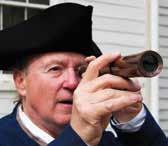
J ohn L. Moore continues to pursue his lifelong interests in Pennsylvania’s colonial history and archaeology.
The Northumberland writer has published 11 non-fiction books about Pennsylvania’s 16th and 17th century. John’s latest book, 1780: Year of Revenge, is currently available in book stores or from the online bookstore Sunbury Press Inc. This book is the 3rd volume in his Revolutionary Pennsylvania Series and tells the story of Indian raids all across the Pennsylvania Frontier — including the Poconos and Minisinks — in the year following General Sullivan’s 1779 invasion of the Iroquios homeland.
Over the years John has participated in archaeological excavations of Native American sites along the Delaware and Susquehanna Rivers. A professional storyteller, he recently took part in the Heritage Festival at Frances Slocum State Park near Wilkes-Barre. He told the true story of Frances Slocum, a 5-year-old girl who lived as a Native American after being kidnapped by Indians during the American Revolution. The park was named for her.
8 POCONO LIVING MAGAZINE © JUNE/JULY 2024
2024PHOTOCONTEST ENTER YOUR BEST SHOTS

Your photos could be seen by more than 26,000 readers when you enter them in Pocono Living Magazine’s Annual Photo Contest. The contest is open to amateur photographers only. (Those who do not earn a majority, over half, of their income as photographers).
You may enter no more than 15 images, so choose your best shots.
Categories are “Scenics”, “Wildlife”, “Florals”, and “Historical Structures”.
Only photographs that are representative of the Pocono Mountains should be submitted. Individual photos should be attached to an email message and sent to: larry@poconomagazines.com. Photos submitted must be high resolution, (300 dpi), jpg or tiff files or they cannot be used. You must include your full name in the title with each photo submitted as you would like it to appear in the magazines. We will contact you for your mailing address to receive your prize if your photo is chosen as a winner in the contest.
Winning photos, along with the names, and hometowns if available, of each winner will appear in the October/November 2024 issue of PoconoLivingMagazine and the PoconoMagazines.com website. Some lucky participants may have their photo featured as a cover on Pocono LivingMagazine!
CATEGORIES
Scenics | Wildlife | Florals | Historical Structures
Your photos could be seen by more than 26,000 readers when you enter them in Pocono Living Magazine’s Annual Photo Contest.
RULES OF THE CONTEST:
1. Contest open to amateur photographers only.
2. Contest opens April 1, 2024 and closes August 1, 2024.
3. Enter electronic files by email to: larry@poconomagazines.com. One photo at a time.
4. Submitted photos must be as an attachment to an email message, (not within the body of the email), and be high resolution (300 dpi), jpeg or tiff files.
5. Please include your contact information (phone number, mailing address & email address) with the submission.
6. Each contestant may submit no more than 15 photographs. Choose any combination of categories.
7. Photos submitted may be judged for inclusion in this year’s contest, and in all future year’s contests, so you have several chances to be a winner.
8. Entered photos must have been taken recently, from January 2014 to present and be of a scene or subject found in the Pocono Mountains only.
9. Categories are: Scenics (landscapes, rivers, lakes, waterfalls, etc.), Wildlife, Florals, and Historical Structures.
10. Judging will take place in August and September 2024.
11. Winners will appear in the October/November issue of Pocono Living Magazine.
12. Contestants will retain all rights to their photography, but agree that Pocono Magazines, LLC and Pocono Mts. Publications, LLC may use their photos from time to time in the magazines that they publish and on the Pocono Magazines.com website provided proper credit is given to each photographer.
Questions? Email the editor at: larry@poconomagazines.com
JUNE/JULY 2024 POCONO LIVING MAGAZINE© 9
Photo by Ray Caswell


LITTLE BEAR AND THE DOG
By John L. Moore
When artist George Catlin visited a heavily fortified trading post called Fort Pierre along the Missouri River in May 1832, he saw “600 families of the Sioux Indians, their tents being pitched in close order on an extensive prairie on the bank of the river.”
Catlin, a Pennsylvanian and a self-taught painter, had been looking for Native Americans to pose for him. William Laidlaw, the trader in charge of the American Fur Co. post, welcomed him, and he stayed for a visit.
The fort was located near present-day Pierre, South Dakota.
“During the few weeks that we remained there, I was busily engaged in painting my portraits, for here were assembled the principal chiefs and medicine men of the nation,” Catlin said.
At Fort Pierre, Catlin first painted Ha-wan-ghee-ta (One Horn), head chief of the Miniconjou Sioux. Then other chiefs and warriors posed. They included Shon-ka (The Dog), chief of the Bad Arrow Points Band and Mah-to-tchee-ga (The Little Bear), a warrior belonging to the Hunkpapa Band.
A Cheyenne chief, Nee-hee-o-ee-woo-tis (The Wolf on the Hill) was also staying at the fort. He joined other native dignitaries and had his portrait done. With long black hair flowing below his shoulders, The Wolf held a lance while posing.
“The chief was clothed in a handsome dress of deer skins, very neatly garnished with broad bands of porcupine quill work down the sleeves of his shirt and his leggings, and all the way fringed with scalp-locks,” the artist said later.
Catlin’s paintings where a novelty to the Indians. “To these people, the operations of my brush were entirely new and unaccountable, and excited amongst them the greatest curiosity imaginable.”
They crowded around him as he painted, eager to see “the result of each fellow’s success, as he came out from under the operation of my brush.”
Catlin used a tepee as a studio. “My room was filled with the chiefs who sat around, arranged according to the rank of grade which they held in the estimation of their tribe.” They required
> Mah-tó-che-ga (Little Bear) was a Hunkpapa (Sioux) warrior. (1832 oil on canvas by George Catlin)
10 POCONO LIVING MAGAZINE © JUNE/JULY 2024
> Shón-ka (The Dog) was chief of the Bad Arrow Points Band (1832 oil on canvas by George Catlin)
him to paint them in the order of their importance. “The first man on the list, was … One Horn, head chief of the nation.”
The artist quickly realized his dilemma. “My models were thus placed before me, whether ugly or beautiful, all the same, and I saw at once there was to be trouble somewhere, as I could not paint them all.”
As Catlin commenced painting inside the tepee, medicine men gathered outside. They shouted in to the chiefs “that they were all fools; that those who were painted would soon die in consequence; and that these pictures, which had life to a considerable degree in them, would live in the hands of white men after they were dead; and make them sleepless and endless trouble.”
“Most of Catlin’s Fort Pierre portraits featured full facial views of the Indians, but the artist decided to paint a side view of Little Bear’s face rather than a full-face picture.”
The chiefs ignored the taunts, and Catlin continued to paint.
As it happened, the last portrait he did at Fort Pierre was that of a celebrated Sioux warrior, The Little Bear.
Most of Catlin’s Fort Pierre portraits featured full facial views of the Indians, but the artist decided to paint a side view of Little Bear’s face rather than a full-face picture. “I was painting almost a profile view of his face, throwing a part of it into shadow, and had it nearly finished,” he said later.
Just then The Dog, “an ill-natured and surly man,” came in. He was in a sullen mood, and sat on the floor in front of Little Bear. Catlin recognized the chief because he had painted his picture several days earlier.
All of a sudden The Dog taunted Little Bear.
“After sitting a while with his arms folded and his lips stiffly arched with contempt, he sneeringly spoke, ‘Mah-to-tcheega is but half a man.’”



The room went silent. Little Bear asked The Dog to explain.
The artist “can tell you,” The Dog said. “He knows you are but half a man. He has painted but one half of your face, and knows the other half is good for nothing!”









JUNE/JULY 2024 POCONO LIVING MAGAZINE© 11 Business Rt. 209 • Snydersville, PA • (570) 992-6634 (Just 5 miles south of Stroudsburg) stonebar.com Classic American Fine Dining Gift Certificates available at StoneBar.com Tues. - Thurs. 5pm - 9pm Fri. & Sat. 5pm - 10pm • Sun. 4pm - 9pm Wednesdays - Pasta Night $25 Thursdays Burgers at Bar - Live Music 6 - 9pm CajunFridays Shrimp - $10 Saturdays Prime Rib Feature “WOW, LookAtAllThatCandy!!”






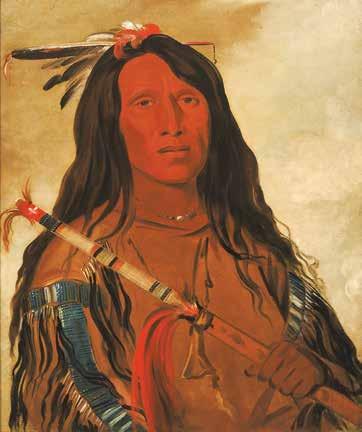
> Né-hee-ó-ee-wóo-tis (Wolf on the Hill) was a Cheyenne chief. (1832 oil on canvas by George Catlin)
The incident ended abruptly when Little Bear remarked that when he looked at The Dog he saw “an old woman and a coward.”
“The Dog rose suddenly from the ground, and wrapping himself in his robe, left the wigwam, considerably agitated, having the laugh of all the chiefs upon him,” Catlin said.
Angry, Little Bear left just as soon as Catlin finished the portrait.
“This was the last picture that I painted amongst the Sioux,” Catlin said years later.
Little Bear went to his tepee and got his gun (Catlin didn’t say whether it was a pistol or a rifle.), loaded it, and put it down long enough to say a prayer. “His wife, in the meantime, seeing him agitated and fearing some evil consequences, without knowing anything of the preliminaries, secretly withdrew the bullet from his gun, and told him not of it.”
hotel MinisinK
As the warrior finished his prayer, The Dog shouted toward Little Bear’s lodge: “If Mah-to-tchee-ga be a whole man, let him come out and prove it. It is Shon-ka that calls him!”
Little Bear’s wife screamed, “but it was too late,” Catlin said. “The gun was in his hand and he sprang out of the door. Both drew and simultaneously fired.”
The Dog’s shot struck Little Bear and knocked him down. Little Bear’s gun had fired, but since it had no bullet, The Dog wasn’t harmed.
12 POCONO LIVING MAGAZINE © JUNE/JULY 2024 Pocono Mountains Airport - 188 Airport Drive, Tobyhanna, PA MoyerAviation.com 1-800-321-5890
Charter Flights Flight Training Other Air Services Gift Certificates Available of the Poconos Automotive Repair & Maintenance 570-234-3113 Mon-Fri 9am - 5pm ASE certified State Inspection 1410 North 5th St Stroudsburg Pennsylvania e history of Delaware Water Gap & ne art exhibits in an old brick schoolhouse. www.dutotmuseum.org 24 Main Street, Rt 611 Delaware Water Gap, PA 18327 Open: 1 - 5pm, Sat. & Sun., May - October (570) 476.4240 Museum & Gallery
Air Tours
ANTOINE DUTOT

“The Dog fled uninjured but The Little Bear lay weltering in his blood,” Catlin said.
Mortally wounded, Little Bear died the next day.
The artist said later that people throughout the village “were fixed upon me as the cause of the calamity.” They reasoned that “I knew that one-half of the man’s face was good for nothing or that I would not have left it out of the picture.”
No longer welcome, Catlin packed his paintings and brushes and left Fort Pierre the day after the shooting.
Accompanied by a few friends, The Dog made good his escape and went into hiding far from the fort.
Weeks later, the artist learned that “councils had been held, and in all the solemnity of Indian medicine and mystery, I had been doomed to die” for having painted the offensive portrait.
At some point, Laidlaw, the trader at Fort Pierre, advised Catlin that Little Bear’s friends were still searching for The Dog. He warned that if they encountered the artist before they found The Dog, “I might possibly fall a victim to their … revenge.”
Eventually Catlin learned that “The Dog had at length been overtaken and killed near the Black Hills, and that the affair might now forever be considered as settled.”


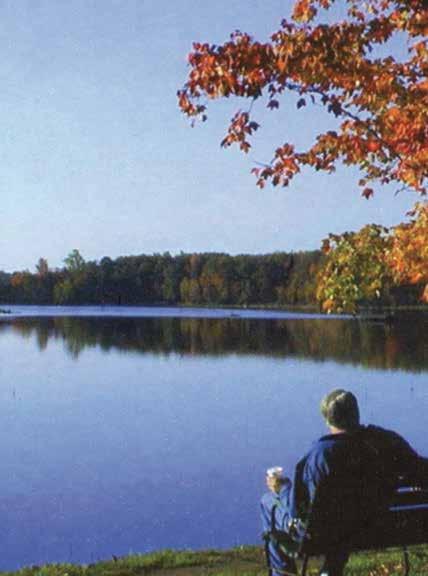
JUNE/JULY 2024 POCONO LIVING MAGAZINE© 13 PLUMBING • HEATING • WATER CONDITIONING COMMERCIAL • RESIDENTIAL •AVAILABLE 24/7 (570) 629-2833 • www.leonclapper.com 425 Neyhart Road, Stroudsburg, PA 18360 Fast, Reliable Service Otter Lake Otter Lake CAMP RESORT P.O. Box 850 • Marshalls Creek, PA 18301 570-223-0123 Reservations only: 800-345-1369 www.otterlake.com • 60 acre lake with 300 campsites • Paved roads • Electric, water and cable TV hook-ups; 100 campsites have sewer hook-ups • 8 heated bathouses, store, laundry and propane • Boating, boat rentals and fishing (no fishing license required) • Indoor pool with 2 Jacuzzis and Sauna • Outdoor Pool • Swimming Beach • Lighted tennis, racquetball and basketball courts • Softball field • Game room, planned activities • Open all year • Woodall 5W rated
> Ha-wón-je-tah (One Horn) was the head chief of the Miniconjou (Sioux) Tribe. (1832 oil on canvas by Gceorge Catlin)
CHEERS AND TEARS
POCONO WILDLIFE THROUGH THE EYES OF A REHABILITATOR
By Kathy Dubin-Uhler

The year I was born, my parents bought a small cottage in Marshall’s Creek, Monroe County. It was quiet and dark. Some of the most vivid memories I have are those of the sounds made by the creatures that lived in the woods and nearby pond. There were deafening numbers of tiny Spring Peeper frogs calling in April and May. The noise was almost intolerable, but the sheer numbers made that experience unforgettable.
Later in spring, the less intense Pickerel and Leopard frogs would call, and then the warm summer evenings were enhanced by the laid-back banjo-like twangs made by Green Frogs and the “jug-of-rum” of Bullfrogs. Other animals were vocal at night as well. Whippoorwills, birds which eat insects in the evening, sang from the darkness and katydids began their loud chorus in August.
In the daytime, birds of the forest sang their songs, hidden by the dense foliage. I wasn’t well versed in the names of all the birds, but I remember Hermit and Wood thrushes and vireos, towhees, and, of course, Robins.
We did see wildlife as well. My parents invested in a red bulb for the spotlight in front of the cabin and directed it right on our birdfeeder. Flying squirrels would come to the feeder at
night, gliding back and forth to their tree cavity nest. We’d see Luna moths and walking sticks resting on the screening of our back porch, from which we’d also feed the chipmunks. I had become so accustomed to seeing deer, squirrels, raccoons and skunks, I assumed that everyone in the world was familiar and comfortable with wildlife.
“Our Open Space programs have proven to be beneficial in protecting choice properties from becoming tax-money consuming housing parcels.”
Today, despite the proliferation of new housing, businesses and roads, many species of wildlife still abound in the Poconos, due especially to the number and size of lands controlled and maintained by the PA Game Commission, DCNR (State Parks), The Delaware Water Gap National Recreation Area, and to conservation groups including The Nature Conservancy and Pocono Heritage Land Trust. Our Open Space programs have proven to be beneficial in protecting choice properties from becoming tax-money consuming housing parcels.
As a young adult, I was so intensely interested in wildlife that I earned my undergraduate and graduate degrees here in the Pocono Mountains learning about wildlife health and habitat and teaching others about the creatures with whom we share northeastern PA. In addition to my position teaching Ecology and Bioethics at Stroudsburg High School, I serve as founder and Director of the Pocono Wildlife Rehabilitation and Education Center, a nonprofit, all-volunteer wildlife care facility. It is work that truly goes without understanding by the public and even friends and family. There are no “summer vacations”, or even entire “days off”. We hear “It must be so much fun to work with the animals” and “I’d love to do what you do”. Spending time with wildlife can be fun, but two recent animals
14 POCONO LIVING MAGAZINE © JUNE/JULY 2024
with which we worked illustrate the very highest highs and deepest lows of wildlife rehabilitation.
One day, we received a call from a gentleman and his wife who were unlucky enough to have a bear cub run headlong into the wheel of his truck while scampering across the road to keep up with his mother and sibling, who crossed safely ahead of him. Unconscious, the limp cub was brought to the wildlife center. After administering pain medication and large quantities of electrolytes, the 25 pound cub was able to open his eyes now and then, and look at us. By evening, he was becoming more alert as we continued hydration and medication for his concussion. We were able to get him to lick blueberry yogurt from a spoon, which picked up his spirits (much in the same way that ice cream does for me when I hurt).The next morning,

yet more food the cub was coaxed to move back to the cleaned cage. This little bruin was ready to be back with his mom.
The PA Game Commission has authority to direct our efforts especially when it comes to dangerous or high-profile animals, such as bears. A call was made notifying them that the cub was ready for release. WCO Cory Bentzoni arrived at the wildlife center and he and Eric wrestled the now 30 pound furry ball of teeth and claws to attach metal ear tags for future identification while I attempted to videotape the process. You wouldn’t think two grown men would have such a hard time piercing the ears of a little bitty cub, but bears are not to be underestimated, at any size! He was then transported to the exact location where his mother and sibling had been spotted, and to the waiting WCO Raymond Lizzio, in whose district the bear was found. He had
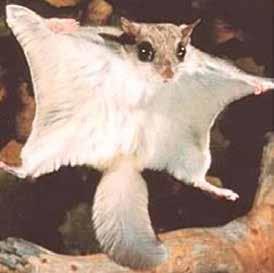
he was able to pick up his head, and ate whatever we put in his mouth- cantaloupe, yogurt, thawed blackberries etc, but he was in a great deal of pain, more than we have medication for here at the wildlife center. A call was made to a local animal hospital which delivered and administered a more appropriate medication for the level of pain and inflammation this poor cub was suffering. By the next day, the little bear was trying to sit up, feeling much better after medication allowed for a good night’s sleep. And then by the next day, little “Boo Boo” knew we were not mom and he was not in Jellystone anymore. He would smack his lips and snort at us- such a big man! Although wobbly, he was able to stand and eat food from a bowl. At this point he was going through two full cups of fruit yogurt, a cup of varied fruits, a half dozen dead chicks, and two cups of “bear formula” a day. Cleaning his cage became a choreography of getting the cub to move from one cage into another. Eric observed him as he ate while I cleaned bear poop and replaced towels and blankets lining his cage. Then, with

scoped out the area and there was a heavily used bear trail, no people for interference, and a pile of pastries placed strategically down the trail for mom and cub to meet. We put the cage on the ground, opened the door, and said our good-byes. The cub took off like a shot, then he stopped, sniffed the air, and gave us a look that provided us confidence that he knew where he was, and he slowly walked away from us down the bear path. Eric and I were exhausted from our week of rehabilitating this cub but the satisfaction, thrill and exhilaration will never be forgotten.
On another day at the center, I received a phone call from off-duty Wildlife Conservation Officer Brad Kreider, who was responding to a call that an immature Bald Eagle had suffered electrocution and fell some fifty feet from a power pole in West Easton. Upon arrival at the wildlife center, the bird was drifting in and out of consciousness, and had a burn injury to his left foot. Animals are weighed upon admission to calculate dosages of medications and to judge their general condition. In
JUNE/JULY 2024 POCONO LIVING MAGAZINE© 15
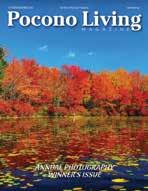



addition to burns and trauma, the young eagle weighed only 7 pounds, at least 3 pounds under normal weight. Young raptors often starve, not because of a lack of prey, but because it takes time to perfect hunting skills. Fluids, medications for shock, trauma, and pain were administered, and an animal hospital with two veterinarians experienced in raptor medicine were alerted that we needed their help as soon as the bird was stable enough to survive x-rays, tests and treatment. We worked with the large brown bird into the night, and by morning he was standing and staring at us. His left leg was bright red, his wing drooped, but he was standing! After a very brief high-five, my husband, Eric, and I rushed the bird to the vet. Following their consult with the well-known University of Minnesota Raptor Center, the prognosis was handed down as very, very poor. We were provided a bag full of topical preparations, antibiotics, pain medications, and a sympathetic handshake to return home from the vet with a very, very injured bird.
“When a wild thing regains its freedom, there is an indescribable feeling of satisfaction that no summer vacation on the beach can equal.”
After a few days, the eagle was able to move about and flap a little. His energy level was up, his pain level was noticeably lower, and he was HUNGRY. Encouraged by his progress, and increasing activity level, we worked day and night, alternating medications, providing calories, fluids and foot massages to try and regain circulation in the leg. Then one morning, we were stunned to find that the small wound on the leg had enlarged and a hole in the skin opened in the wing. We rushed to the animal hospital, where we were informed that, similar to frostbite, damage from electricity becomes visible days after the injury. We treated aggressively, but by the next morning, the vast amount of tissue damage caused by the electric jolt received by this beautiful young eagle took his life. We were crushed. We sat and held the bird, not speaking, incredulous that such a life force was taken after so very much care.
Working with wildlife, from songbirds to raptors and opossums to bears, requires not only education and training in the medical evaluation and treatment of animals, but their diets, handling and keeping stress in captivity to a minimum. In addition, much of the work is tedious, filling out the mountains of paperwork required of us, cleaning
Pocono Living Magazine Pocono Family Magazine ACCESS YOUR FAVORITE POCONO MAGAZINES ONLINE ANY DEVICE, ANYTIME, ANY PLACE www.PoconoMagazines.com • READ CURRENT & PAST ISSUES • SUBSCRIBE FOR FREE • NEVER MISS ANOTHER ISSUE and go to:
16 POCONO LIVING MAGAZINE © JUNE/JULY 2024
cages, and answering hundreds and hundreds of phone calls. The losses are painful, especially when unexpected or after a great deal of hands-on rehabilitation time, but despite the losses Eric and I continue to be optimistic in the face of severe injuries or when working with a difficult species. When a wild thing regains its freedom, there is an indescribable feeling of satisfaction that no summer vacation on the beach can equal.
“Spending time with wildlife can be fun, but two recent animals with which we worked illustrate the very highest highs and deepest lows of wildlife rehabilitation.”
The PWREC is a nonprofit, all-volunteer organization which treats all native species of wildlife, returning healthy individuals to the wild, provided education and advice to individuals and groups of all sizes and ages about many wildlife issues, and provided a buffer against disease and injury to the public by maintaining a professional facility to which animals in need of help can be brought. The PWREC holds licenses from the PA Game Commission, US Fish and Wildlife Service and US Dept of Agriculture, none of which fund our efforts, but provide us with mountains of paperwork that allow us to do our work legally! Currently, this is the only all-volunteer, all-species facility in the Pocono region. The facility is funded by donations from individuals and from our live wildlife education programs. We have no corporate sponsors, as yet, but would be delighted to have that support. Please consider visiting our website, www.poconowildlife.org , providing a tax-deductible donation, requesting a live wildlife demonstration for your organization, community or school, or donating time to complete one of our projects.
KATHY DUBIN-UHLER
Katherine Uhler is the director of the Pocono Wildlife Rehabilitation and Education Center. She became a licensed wildlife rehabilitator in 1980 and has been growing the nonprofit, all-volunteer PWREC since. In addition to running the Center with her husband and co-director, Eric, she has earned a Master’s Degree in Wildlife Biology and teaches Ecology at Stroudsburg High School.
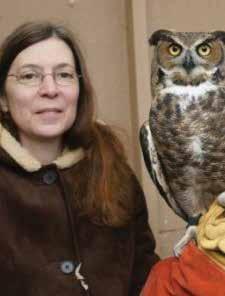




JUNE/JULY 2024 POCONO LIVING MAGAZINE© 17 1411 Chipperfield Drive Stroudsburg, PA 18360 Mark Citera Owner (570) 420-9764 info@citerameats.com www.citerameats.com FRESH NAT U R AL MEATS MEAT MARKET SIN C E 1 98 3 FAMILY /citerameats Rudy’s Your Neighborhood Tavern Established in 1933 90 Washington Street, East Stroudsburg, PA 18301 570-424-1131 (570) 476-0211 • www.thewillowtreeinn.net 601 Ann Street, Stroudsburg, PA Willowtree Inn Serving fine food & spirits in an elegant setting
INDEPENDENCE DAY
By Suzanne McCool
What does the 4th of July or “Independence Day” mean to you? Over the years, at various times, I have thought how happy I am to be born an American and to live in America. I have traveled to approximately 20 countries in the world, and while I have enjoyed my trips abroad, I was always happy to be back in the good ol’ USA!
I do cherish our freedoms and I have counted my blessings that our forefathers were such courageous, honest, and ethical individuals. Our American story could have been so different if we hadn’t had people like Ben Franklin, Thomas Jefferson, Paul Revere, George Washington, Samuel Adams, and many others to lead us to freedom.
The decision to separate from England was not made lightly. Thoughtful, highly moral people felt it was the right thing to do. Our ancestors fought a long, difficult war to secure the freedoms we all cherish today. We should all be thankful for the sacrifices they made to start a new nation conceived with the idea of liberty for all.
At the time I was in high school, we had to memorize the first paragraph of The Declaration of Independence in our history classes. It is thrilling writing. Do you remember it?
And I quote....
“When in the Course of human Events, it becomes necessary for one People to dissolve the Political Bands which have connected them with another, and to assume among the Powers of the Earth, the separate and equal Station to which the Laws of Nature and Nature’s God entitle them, a decent Respect to the Opinions of Mankind requires that they should declare the causes which impel them to the Separation. We hold these truths to be self-evident, that all Men are created equal, that they are endowed by their creator with certain unalienable Rights, that among these are Life, Liberty, and the Pursuit of Happiness – That to secure these Rights, Governments are instituted among Men, deriving their just Powers from the Consent of the Governed, that whenever any Form of Government becomes destructive of these Ends, it is the Right of the People to alter or to abolish it, and to institute a new Government, laying its Foundation on such Principles, and organizing its Powers in such Form, as to them shall seem most likely to effect their Safety and Happiness.”
Note that many words were capitalized by the authors of the Declaration of Independence to emphasis their importance at that time.
The Declaration goes on for several more pages. It can easily be found on-line today, and I encourage everyone on this Fourth of July to read it, and appreciate the beauty of our American system of government.

18 POCONO LIVING MAGAZINE © JUNE/JULY 2024

Guide to the Delaware Water Gap National Recreation Area
Annual
MAGAZINE
The Pocono Mountains' Magazine
DELAWARE WATER GAP NATIONAL RECREATION AREA
Located between the Pocono Plateau and Kittatinny Ridge in close proximity to the most densely populated region of the nation, Delaware Water Gap National Recreation Area and the Middle Delaware National Scenic and Recreational River preserve the natural, cultural, and scenic resources and values of the Delaware River valley and provide opportunities for resource-based recreation, education, and enjoyment
PARK REGULATIONS & SAFETY
• Launching, landing or operating an unmanned aircraft from or on lands and waters administered by the National Park Service within the boundaries of Delaware Water Gap National Recreation Area is prohibited except as approved in writing by the Superintendent.
• Climbing, jumping, diving, and rappelling is prohibited at all waterfalls, waterfall pools, and bridge abutments.
• Swimming and wading is prohibited within 50 feet upstream of waterfalls.
• Entry into caves, mine shafts and unoccupied structures is prohibited.
• Privately-owned property and residences exist within park boundaries. Please respect the rights and privacy of private property owners and other residents.
• Collection of plants, animals, rocks, mineral, and cultural objects is prohibited.
• Certain types of activities require a special use permit. Some common activities that require a permit include commercial photography, weddings, baptisms, first amendment activities, and competitive events.
• A permit is required for any road-based tour operating within the park. Road-based commercial tours are considered as one or more persons traveling on an improved roadway on an itinerary that a company or individual has packaged, priced, or sold for leisure/recreational purposes.
• Camp fires are only allowed at designated camp sites within metal fire grates. Personally owned grills, stoves, or lanterns are permitted at designated picnic sites (excluding Kittatinny Point and Childs Park), campground or river campsite. Fires are prohibited in all other areas.
• Do not feed or approach wildlife. Always maintain a distance of at least 100 yards from bears and 25 yards from other wildlife.
For a complete list of park specific closures, permit requirements and other restrictions, contact park headquarters at 570 426-2452.
CONTACT US
Main Address
Park Headquarters
1978 River Road, Bushkill, Pennsylvania 18324
Email: DEWA_Interpretation@nps.gov
Park Headquarters Emergency 570-426-2452 800-543-4295
Website and Social Media
www.nps.gov/dewa www.facebook.com/DelWaterGapNPS www.twitter.com/DelWaterGapNPS www.instagram.com/DelWaterGapNPS
The National Park Service cares for the special places saved by the American people so that all may experience our heritage.
PETS
Pets must be restrained on a leash (6 feet or less). Pets may not be tied to an object and left unattended or left in a vehicle. Summer heat poses a threat to pets left in vehicles. Report lost pets to the park communication center at 570- 426-2457.
Please follow the rules of BARK! when visiting the park with your pet.
Bag your pet’s waste
Always wear a leash
Respect wildlife
Know where you can go
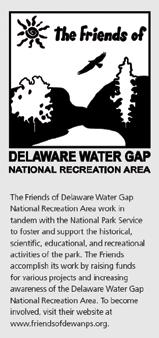
Pets are permitted in most areas of the park, including campgrounds, picnic areas, and on paved or dirt roads.
Pets are NOT permitted at the following sites (excludes working service animals):
In Pennsylvania: Raymondskill Falls and Raymondskill Creek Trail Dingmans Falls and Dingmans Creek Trail Valley View Group Campsites Memorial Day weekend through Labor Day: Smithfield Beach, Milford Beach, and Hialeah Picnic Area (except when accessing the McDade Trailhead)
In New Jersey: Turtle Beach Rivers Bend Group Campsites Watergate Recreation Site
2 | Guide to the Gap

CONTENT
THE RIVER, THE VALLEY & YOU
» page 4
SUGGESTED TRIP
» page 6
A DAY ON THE DELAWARE
» page 8
SWIMMING & FISHING
» page 10
CAMPING
» page 12
PICNICKING & RIDING
» page 13
BIKING
» page 13
HIKING
» page 14
RIVER RUNNER SHUTTLE
» page 18
TOURING OLD MINE ROAD
» page 20
OVERLOOKS IN THE GAP
» page 22
WATERFALLS
» page 23
PEOPLE OF THE DELAWARE
» page 26
Guide to the Gap | 3
Tumbling Waters

THE RIVER, THE VALLEY, AND YOU
Paddlers slip down the river between low, forested mountains; anglers wade the cool streams; and hikers explore secluded places. This valley has attracted people for 13,000 years.
Abundant plant and wildlife sustained American Indians; floodplains nourished early farmer’s crops; waterfalls drew Victorian vacationers. Today, a 70,000-acre park welcomes you to the enticing Delaware Water Gap National Recreation Area and Middle Delaware National Scenic and Recreational River.
Millions of years of uplift, erosion, and glacial activity gave us the water gap, ridges, and streams that flow through hemlockand rhododendron-laced ravines and over waterfalls that pour off the Pocono Plateau.
Steeped in rich history, the trails, roads, sites, and traces reveal reminders of times gone. The Minsi Path and Minisink Trail converged on a Delaware River island that was once the center of a large American Indian settlement. Agricultural fields still in cultivation help preserve the rural landscape predominate in the 18th century. In the 1800s resorts flourished throughout the region where city dwellers arrived by carriage or rail, often spending the entire summer away from the urban heat. The water gap became a scenic wonder for fashionable travelers.
Today the natural and cultural wonders provide abundant recreational opportunities. This rural vacationland is yours to explore.

RIVER ACTIVITIES
Delaware Water Gap National Recreation Area includes nearly forty miles of the free-flowing Middle Delaware Scenic and Recreational River.
River-related activities, like swimming and paddling, are some of the popular pastimes on warm summer days.

TRAILS
From ridgetop to riverside, vistas to ravines, and from easy to extreme, more than 100 miles of trail offer something for everyone.
Choose a trail for hiking, biking, or boating to enjoy the natural beauty and the historic landscape of the river valley.

AUTO TOURS
Although the park is close to major cities, tranquil drives invite exploration. More than 100 miles of road lead to wonderful places.
Explore the varied landscapes in the valley: forests and fields, ridges and ravines, historic houses and hamlets
4 | Guide to the Gap
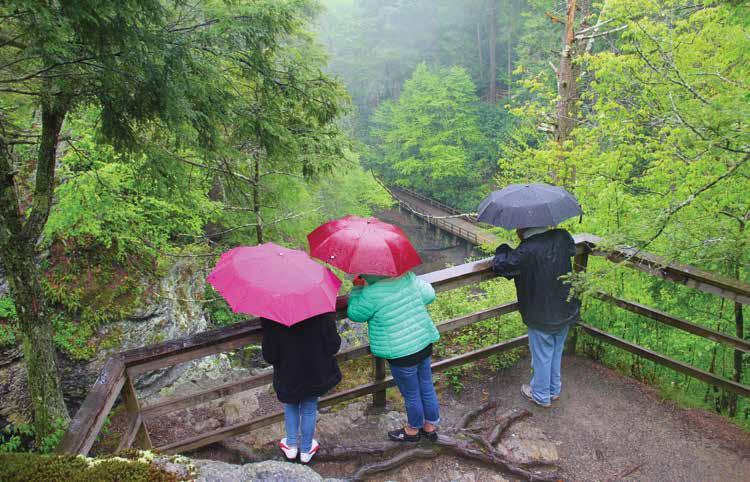

Guide to the Gap | 5

6 | Guide to the Gap
Fulmer Falls
SUGGESTED TRIP ITINERARIES
Delaware Water Gap National Recreation Area offers endless opportunities for exploration and discovery. The following are a few suggested itineraries to consider depending on your time and interests.
IF YOU HAVE A FEW HOURS:
• Stop by a park visitor center, where park rangers and volunteers can help you plan your adventure. Visitor center parking lots fill quickly on summer weekends. To avoid the crowds, visit the area before 10:00 am or after 4:00 pm on weekends or visit on a weekday.
• Walk a section of the McDade Recreational Trail, which extends most the length of the park in Pennsylvania and presents some of the best views of the Delaware River, as well as passes by charming streams, open farm fields, forests, and historic landscapes. On Saturdays, Sundays, and holidays between Memorial Day Weekend and Labor Day Weekend, use the River Runner Shuttle for your return trip along the trail.
• View Raymondskill Falls by hiking a short, but steep, trail. To avoid the crowds, visit the area before 10:00 am or after 4:00 pm on weekends or visit on a weekday.
• Wander the quiet streets of Millbrook Village and explore life in the 1800s. This area is generally a good place to avoid crowds on summer weekends. Select buildings are open on summer Saturdays.
• Tour the Nelden-Roberts Stonehouse and the Foster-Armstrong House in Montague, NJ, on a summer Sunday afternoon. This area is generally a good place to avoid crowds on summer weekends.
• Tour the Rosencrans House and the Van Campen Inn in Walpack Center, NJ, on a summer Sunday afternoon. This area is generally a good place to avoid crowds on summer weekends.
• Stop at the three overlooks along PA 611 for stunning views of the Delaware Water Gap.
IF YOU HAVE HALF A DAY:
• Take a bike ride along the McDade Recreational Trail. Bring your own or rent a bike from a local outfitter. On Saturdays, Sundays, and holidays between Memorial Day Weekend and Labor Day Weekend, use the River Runner Shuttle to transport you and your bike, then ride back to your vehicle.
• Savor a picnic lunch at Hidden Lake and then take a stroll around the lake. This area is generally a good place to avoid crowds on summer weekends.
• Stroll around the Slateford Loop Trail to enjoy the quiet valley below the Kittatinny Ridge.
• Take a scenic drive along US 209.
• Choose a trail and venture on a hike.

IF YOU HAVE ALL DAY:
Consider signing up for a workshop offered by one of our partners located within the park.
• Peters Valley School of Craft offers 2-day to 5-day fine craft workshops. For more information, visit petersvalley.org.
• Appalachian Mountain Club’s Mohican Outdoor Center offers weekend getaways focusing on various outdoor activities. For more information, visit outdoors.org/lodging-camping/Lodges/Mohican.
• Pocono Environmental Education Center offers weekend getaways and workshops for youth, families and adults. For more information, visit peec.org.
Guide to the Gap | 7
View from Mt. Tammany (on the Red Dot & Blue Blaze trails)
A DAY ON THE DELAWARE RIVER
The Delaware River is the longest undammed United States river east of the Mississippi, extending 330 miles from Hancock, New York to the Atlantic Ocean. The Delaware River Water Trail extends nearly 200 miles from Hancock to Trenton, New Jersey. Like a conventional trail, a water trail is a recreational corridor, but instead of hiking, it is traveled by boat, such as canoe, kayak or small-motorized watercraft.
The river boasts outstanding natural, cultural, recreational and scenic resources. In recognition of these qualities, the portion of the Delaware River traveling through Delaware Water Gap National Recreation Area was officially designated as the Middle Delaware National Scenic and Recreational River in 1978. Within the park, the river is a series of shallow riffles and deep pools, making this section particularly good for canoeing. Access points every eight to ten miles allow for easy day trips, and numerous primitive campsites allow for longer journeys.
Bringing your own kayak or canoe? Take the chore out of relaying vehicles between your put-in and take-out on summer weekends. Use the River Runner Shuttle to transport you, your kayak and canoe, and your gear on Saturdays, Sundays and holidays Memorial Day weekend to Labor Day weekend. The service is free.
A day on the Delaware River allows you an opportunity to immerse yourself in an environment of tranquil natural landscapes, striking river valley scenery, and a substantially undeveloped river corridor that is unmatched among large rivers in the most densely populated region of the United States. While the Delaware River is easy for boaters, do not be misled by its calm appearance. Always follow proper water safety precautions to ensure you have a safe and enjoyable experience.

8 | Guide to the Gap

Guide to the Gap | 9
Buttermilk Falls
SWIMMING
Pack a swimsuit and a picnic and head to the beach - the river beach, that is. Unlike the sandy beaches along the ocean, the beaches here have soft grass on which to stretch out and enjoy the day.
Milford, Smithfield, and Turtle beaches are designated swim areas. Lifeguards monitor the beaches on weekends mid-June through Labor Day. Swimming in other areas of the river is not recommended. Picnic and restroom facilities are also available at the beaches. Grills are not provided, but personal grills are permitted. Alcohol and pets are not permitted.
Parking at swim beaches generally reaches capacity by 10:00 am on summer weekends. On Saturdays, Sundays, and holidays during the summer, consider parking at the Delaware Water Gap park-and-ride lot and riding the free River Runner Shuttle to Smithfield beach.
FISHING
Pack a swimsuit and a picnic and head to the beach - the river beach, that is. Unlike the sandy beaches along the ocean, the beaches here have soft grass on which to stretch out and enjoy the day.
Milford, Smithfield, and Turtle beaches are designated swim areas. Lifeguards monitor the beaches on weekends mid-June through Labor Day. Swimming in other areas of the river is not recommended. Picnic and restroom facilities are also available at the beaches. Grills are not provided, but personal grills are permitted. Alcohol and pets are not permitted.
Parking at swim beaches generally reaches capacity by 10:00 am on summer weekends. On Saturdays, Sundays, and holidays during the summer, consider parking at the Delaware Water Gap park-and-ride lot and riding the free River Runner Shuttle to Smithfield beach.
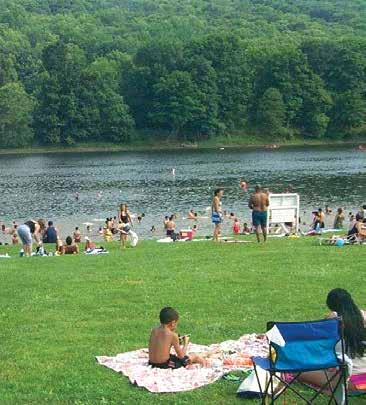


10 | Guide to the Gap
REGULATIONS
• A state fishing license is required for those 16 and older; regulations are enforced.
• Holders of either a New Jersey or Pennsylvania license may fish on the Delaware River and from either of its banks. This does not apply to the river’s tributaries.
• Special fishing regulations apply within the park. Refer to the appropriate state regulations for waters within the park.
Fishing is not permitted at:
• Dingmans Creek within George W. Childs Park area, including foot bridges and observation platforms. (Site closed in 2019)
• Dingmans Creek from the top of the Dingmans Falls to the east end of the Dingmans Falls Visitor Center parking lot from 8:00 am to 5:00 pm daily.
• Silverthread Falls in the pool at the base of the falls.
WATER SAFETY
Planning a safe day at the river begins well before you get near the water and does not end until you return home. Even though the Delaware River appears calm in some areas, DO NOT be misled! Moving water must be respected. The information below will help you better understand how to safely and comfortably enjoy the river.

In General:
• Always wear your life jacket.
• Alcoholic beverages are prohibited at Milford Beach, Smithfield Beach, Kittatinny Point, and Hialeah Picnic Area in Pennsylvania, and Turtle Beach, Caddoo Worthington State Forest, and Tocks and Labar Islands in New Jersey. Alcoholic beverages are also prohibited between Depew Island on the north and Depue Island on the south.
• Do not drink during river activities.
• Wear shoes to protect your feet from sharp stones, glass, and other objects.
• Protect yourself from the sun; wear sunscreen, a hat, light clothing, and sunglasses.
• Stay hydrated. Bring and drink plenty of water. Do not drink river water unless it is boiled at least 10 minutes.
• Plan to be off the river before dark.
When Swimming:
• Wear your life jacket even when swimming; don’t overestimate your swimming ability.
• Do not attempt to swim or wade across the river. The Delaware River has strong currents and steep drop-offs. Swimming becomes more difficult with increased current and water depth. Even the strongest of swimmers should be extremely cautious.
• Swim at designated beaches. Lifeguards are on duty on weekends at Milford, Smithfield and Turtle beaches mid-June through Labor Day.
• Do not jump or dive from cliffs, rocks, or bridges into the river; the water may be shallow and objects can be submerged. Rivers are constantly changing, especially with high water. Rocks can show up in places they never were before.
• Do not swim alone - always stay with your group.
When Boating:
• Always wear your life jacket.
• Children 12 years of age and younger MUST WEAR a life jacket on board a vessel.
• Life jackets must be worn in vessels less than 16 feet between November 1 and April 30.
• Never stand in a canoe. For better balance, kneel in a canoe when going through rapids.
• If you capsize, don’t panic. Stay with your boat; even an overturned boat can support you. Keep upstream of your boat to avoid being pinned against a rock or obstacle. Float on your back with your feet pointed downstream. Use your paddle to push away from rocks and other obstacles. Retrieve boats and equipment only if it can be done safely.
• Be ready for changing weather and cold water. Bring rain gear. To protect against hypothermia, bring clothing made of wool, polypropylene, high-performance eece, or a wetsuit.
• Never try to stand in rapids. Your foot could become trapped between submerged rocks. With a foot trapped, the current can be strong enough to push you over and hold you under, even if you are wearing a life jacket.
• Always tell someone where you are going and when you expect to return. Arrange drop off and pick up points before you leave. Leave emergency phone numbers, vehicle description, and tag numbers with someone who can report that you are overdue.
• Bring a spare paddle, a throw line, whistle, and a first aid kit.
Guide to the Gap | 11
CAMPING
What better way to immerse yourself in an environment of solitude, tranquil natural landscapes, striking river valley scenery, and a substantially undeveloped river corridor than to go camping! Whether you enjoy the services available at a campground or prefer hiking or paddling to pitch a tent away from people, the park offers a campsite for you. The place you park your RV or set up your tent becomes your home away from home – make it a safe one.
In general:
• Make sure there are no dead limbs or trees in the vicinity of your campsite that might come down during a strong wind.
• Avoid drinking untreated water. Even clear, spring water can contain harmful bacteria.
• If in a campground, lock food in your vehicle. Bears and other wildlife have a great sense of smell.
• Keep your pet on a leash and never leave a pet unattended.
• Ground fires are prohibited, except in a provided fire grate.
• Do not bring wood from outside the park; firewood is available for purchase at Dingmans Campground.
• Collecting wood in the park for fires is prohibited, except downed wood within designated campsites.
DINGMANS CAMPGROUND
Located near Dingmans Ferry, PA
• Sites for tent and RV (some with hook-ups)
• Individual and group campsites
• Camp store
• Weekly activities
• River Runner Shuttle flag stop
• More information: dingmanscampground.com
MOHICAN OUTDOOR CENTER
Located along the Appalachian National Scenic Trail near Blairstown, NJ
• Individual and group tent sites
• Self-service, bunk-style cabins
• Water available
• Camp store & food service
• More information: outdoors.org/lodging/lodges/mohican
GROUP CAMPSITES
Valley View Located near Bushkill, PA
Rivers Bend Located near Millbrook Village, NJ
• Reservations required
• Available for groups of 20-40
• Primitive tent sites along the river
• Water available at Rivers Bend only
• River access for canoes and kayaks
• Valley View Campground is a River Runner Shuttle flag stop (1/3-mile walk)
• More information: nps.gov/dewa
RIVER CAMPING
For extended boat trips (14 miles or more), free primitive campsites along the river are available first-come, firstserve. Additionally, six sites at the Alosa Campsite are available by reservation only. For Alosa Campsite reservations visit recreation.gov and search for Alosa. Service charges will apply when making reservations either by phone or at recreation.gov.
River camping is limited to boaters on trips of at least 14 miles total for one night, 26 miles total for two nights and 34 miles total for three nights.
KEY REGULATIONS
• Camping along the river is permitted in designated sites only; sites are identified by signs and the presence of a steel fire grate.
• Camping is limited to one night at each location. Campsites are limited to five tents per campsite.
• Tents must be erected within 50 feet of the campsite fire grate.
• Fires permitted in existing fire grates only. Self-contained stoves are permitted.
• Collecting wood in the park for fires is prohibited, except downed wood within the designated campsite. Do not bring wood from outside the park; firewood is available for purchase at Dingmans Campground.
• Pack out what you pack in, including food scraps.
• Use soaps sparingly; even biodegradable soap is a pollutant.
• Do not urinate or defecate within 100 feet of any river or stream. Bury fecal material, including pet waste, at least six inches deep and at least 100 feet away from water.
• Leave what you find; digging, collecting, or removing objects is prohibited.
12 | Guide to the Gap
PICNICKING
Numerous idyllic spots in the park await you and a red-checkered blanket. Grills are not provided anywhere in the park, but you are welcome to bring your own, except to Kittatinny Point. Ground fires are prohibited throughout the park. Do not bring wood from outside the park for any purpose; it may contain invasive insects and other organisms that threaten the survival of local plant and animal life. Collecting wood in the park for fires is also expressly prohibited, since even the smallest twig may serve as a critical habitat or food source for protected plant and animal life.

RIDING
Normally, horse riding is permitted on the Conashaugh View Trail in Pennsylvania and the Upper Ridge Trail in New Jersey for those who have their own horses. However, the Conashaugh View Trail sustained significant damage during a March 2018 winter storm and is closed to all recreational use until trail repairs are complete. Contact park headquarters at 570.426.2452 or visit the park’s website at www.nps.gov/dewa for the current status.
The Upper Ridge Trail near Layton, New Jersey, winds approximately five miles (in and back) through quiet woods, open fields and past isolated ponds. This trail is not heavily used and can become overgrown in the summer. Parking for trailers is along Jager Road. The trail is also open to hiking. Hikers should be alert to riders and must yield to horses by stepping off the trail and standing quietly until they pass. Please protect the environment by riding only on the marked trails, and crossing streams only on bridges. There are no horse rental liveries in the park.
BIKING
Cycling is a popular form of recreation in the park. The McDade Recreational Trail, a packed gravel path, parallels the Delaware River on the Pennsylvania side of the park for 32 miles and is perfect for mountain and hybrid bikes. This is the only trail where biking is permitted. A section between White Pines and Pittman Orchard trailheads is closed to biking. Motorized vehicles are not permitted on the McDade Recreational Trail.
Old Mine Road parallels the Delaware River on the New Jersey side for 34 miles in the park and passes through historic landscapes.
Road biking on US 209 in Pennsylvania is not recommended due to heavy traffic. Road biking on River Road in Pennsylvania is strongly discouraged due to sharp, steep turns, blind curves, and the lack of shoulders.
» Subject to change, please visit the park website or contact the park for updated information before visiting.
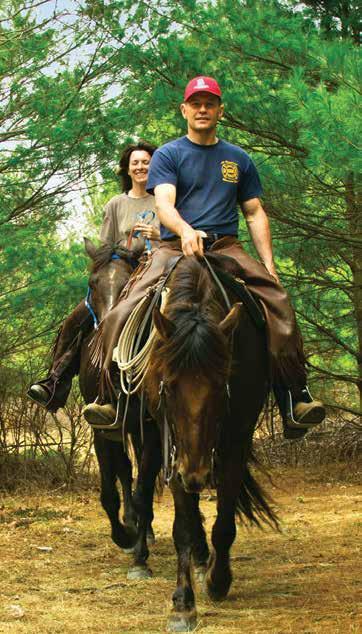
Guide to the Gap | 13
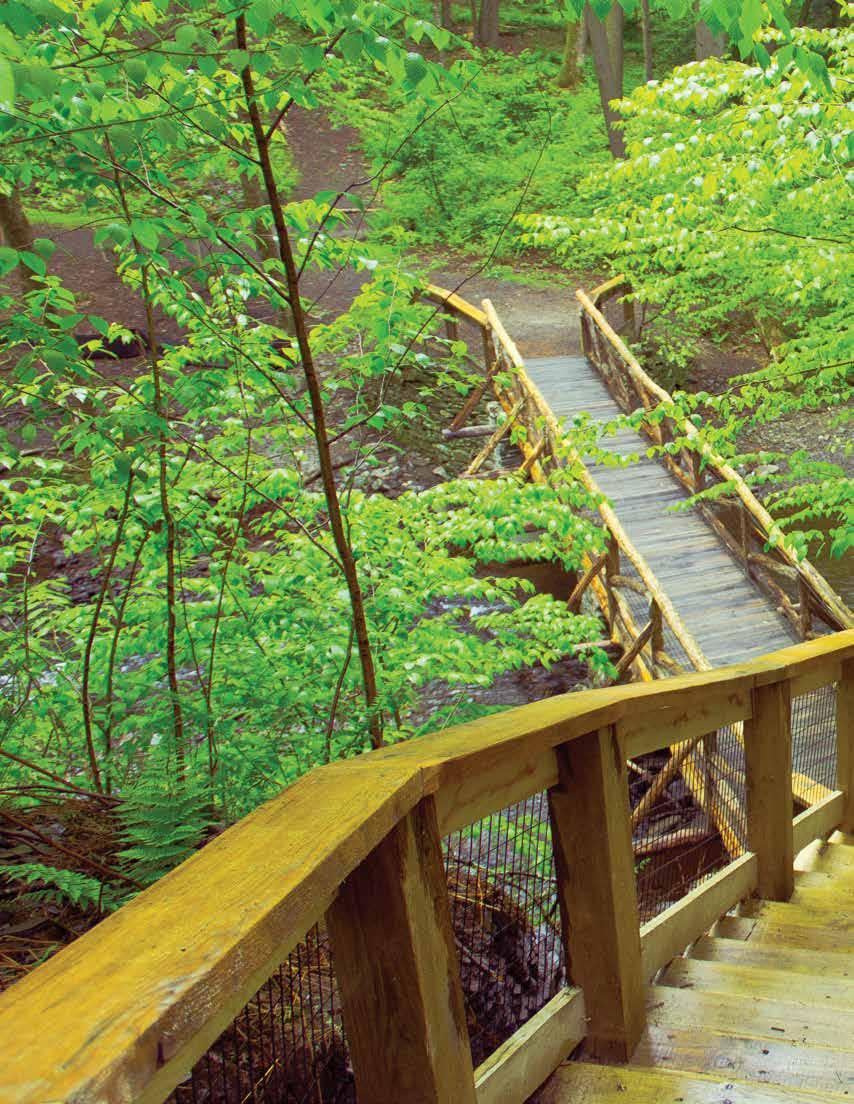
HIKING
More than 100 miles of trails meander through the park, including nearly 27 miles of the Appalachian National Scenic Trail. Hikers can enjoy the trails year-round, with each season offering its own special reward. During winter, the absence of deciduous leaves opens new vistas along trails and reveals stone walls, foundations, and other reminders of past residents. Spring provides a weekly parade of wild flowers and flowering trees. In summer, hikers can seek out cool retreats among the hemlock forests, and follow burbling streams to powerful falls and cascades. In autumn, hikers have crisp air to sharpen their senses and a wondrous palette of fall colors to enjoy.
Choosing a trail can be a daunting task. What to see? Waterfalls? Historic landscapes? Inspiring views? The following pages offer a simple guide to the many routes available.
BE PREPARED FOR YOUR VISIT
• Cell phone service is limited within the park.
• Carry (and drink) plenty of water; a leading cause of injuries on the trail is dehydration.
• Protect yourself from the sun; wear a hat, sunglasses and sunscreen.
• Wear sturdy shoes.
• Protect yourself from ticks and insects; use insect repellent, check and remove ticks when you return, and wear light-colored clothing to spot ticks more easily.
• Stay alert for snakes; do not put your hands and feet into places you cannot see.
• Be bear-aware; do not run if a bear approaches; make noise, wave your arms, and look large.
• Be able to recognize poison ivy and avoid contact with the plant.
• Trails are not regularly maintained or patrolled; travel carefully and at your own risk.
• Wear bright orange (shirt, vest, or hat) during hunting season.
KEY REGULATIONS
• Stay on trails; taking shortcuts causes trail erosion, damages native plants, and can be dangerous.

• Do not feed or approach wildlife.
• Be Bear Aware; stay at least 100 yard from bears, hike in groups of three or more, make noise, and properly store trash and any products with an odor.
• Pets must be leashed at all time
• Pack out what you pack in; do not leave trash behind.
HIKER SHUTTLE
The parking lots at Kittatinny Point and Dunnfield are generally full by 10 am on summer weekends. Monroe County Transit Authority offers a hiker shuttle between the Delaware Water Gap Park and Ride, Lake Lenape Trailhead, and the Kittatinny Point and Dunnfield parking lots. Service is offered every half hour between 10 am and 5:30 pm on Saturdays, Sundays, and holidays between Memorial Day and Labor Day weekends.
14 | Guide to the Gap

Guide to the Gap | 15
Childs Park Trail
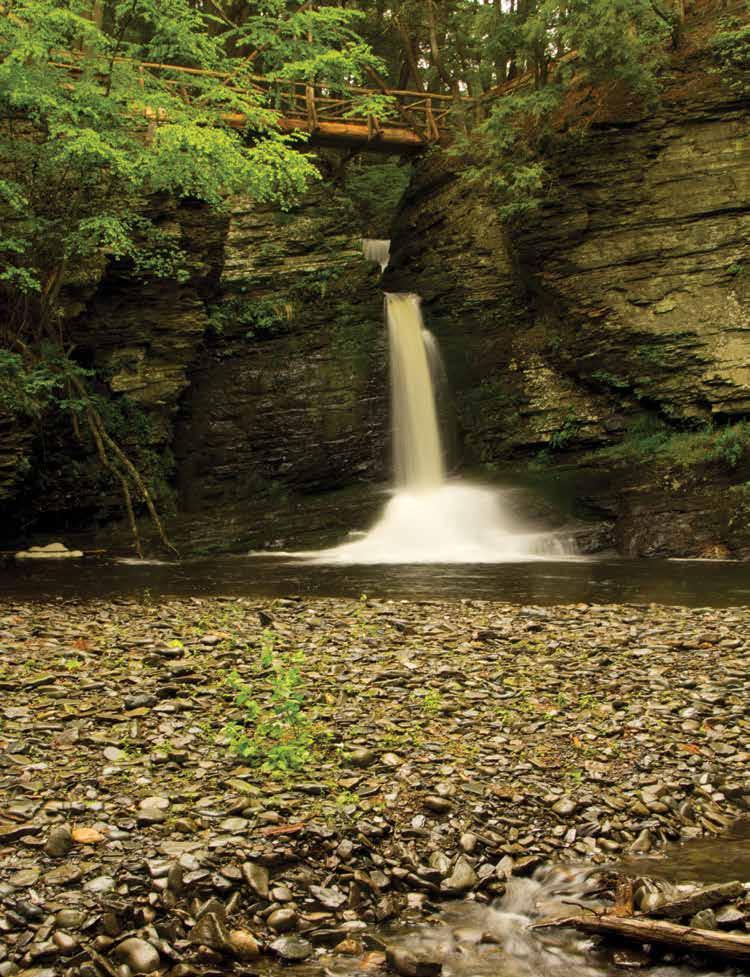
16 | Guide to the Gap
Deer Leap Falls

Guide to the Gap | 17
Dingmans Falls
Photo by: Lou Nunez
RIVER RUNNER SHUTTLE
The National Park Service has partnered with Monroe County Transit Authority (MCTA) to provide free public bus service along the Pennsylvania side of the river. MTCA provides the River Runner Shuttle service on Saturdays and Sundays between Memorial Day and Labor Day weekends between Stroudsburg, PA and Milford Beach, PA. Additionally, bus service is provided on Memorial Day, Independence Day, and Labor Day.
The River Runner Shuttle is a free service and is ADA accessible. Pick your boarding location and destination using the schedule below. Be at the stop five minutes prior to the scheduled arrival with your gear ready to load. In addition to passengers, MCTA can also transport bicycles, canoes, kayaks, and leashed dogs. Passengers are required to load and secure their own belongings and MCTA operators will check the equipment to ensure it is properly stowed.
Loading and securing equipment takes some time, so please be aw are that there may be times when the bus is late. For groups of ten or more people, please contact MCTA in advance to ensure they are properly prepared for your large group.
The system is designed to enable riders to board the bus just a bout anywhere along the route where it is safe for the driver
stop. Simply wave to the shuttle driver from a safe and observa ble location. Remember to be at the stop five minutes before the scheduled time. Programs like the River Runner Shuttle are just one way the par k is working to lessen the footprint we all leave on the planet. For more information about the shuttle visit MCTA’s website at gomcta.com/trip or call 570


t o
243-3400. 209 739 2001 209 206 NEW JERSEY erawaleD reviR drofliM drofliM daoR Pittman Orchard Egypt Mills Eshback Access Jerry Lees Pocono Environmental Education Center Dingmans Falls Visitor Center Schneider Farm Dingmans Campground 560 White Pines Conashaugh
PENNSYLVANIA



SHUTTLE RIDING TIPS
For Boaters:
• Northbound shuttle service can be crowded with boaters, particularly in the morning. Consider riding your bike north on the McDade Recreational Trail and using the southbound shuttle to return to your vehicle.
• Riders are strongly encouraged to park at the Park-and-Ride in Delaware Water Gap for river trips that end at Kittatinny Point due to traffic congestion on summer weekends.
For Hikers:
• Hike a longer one-way trip on the McDade Recreational Trail by using the shuttle.
• Northbound shuttle service can be crowded with boaters, particularly in the morning. Consider hiking north on the McDade Recreational Trail and using the southbound shuttle to return to your vehicle.
• Peak demand for canoe and kayak shuttle is northbound in the morning before 10 am. Consider using the northbound shuttle to transport to your starting location later in the day, or use the northbound shuttle to transport back to your parked vehicle at the end of your trip.
• Have your gear at the shuttle stop and ready to load at least ten minutes before departure to ensure on-time service.
For Swimmers:
• When spending the day at Smithfield Beach, use the shuttle to go to the McDade Trailhead at Hialeah for a 1.9-mile walk back to Smithfield Beach.
• When spending the day at Milford Beach, use the shuttle to go to the McDade Trailhead at Pittman Orchard for a 2.2-mile walk back to Milford Beach.
• River Runner shuttle service is not available at Kittatinny Point after 8:50 am.
• The last northbound shuttle leaves Smithfield Beach at 3:20 pm. The last southbound shuttle leaves Milford Beach at 4:50 pm
For Bikers:
• Bike a longer one-way trip on the McDade Recreational Trail by using the shuttle.
» Subject to change, please visit the park website or contact the park for updated information before visiting.
209 209 80 2001 Lake Lenape DELAWARE WATER GAP
M reviR dR dlO eniM daoR Bushkill Falls Road nameerF tcarT daoR Riverview Bushkill WORTHINGTON STATE FOREST Shawnee on Delaware Hialeah Smithfield Beach (Fee area) Turn Farm Owens Park Headquarters Bushkill Village Bushkill Access (Fee area) Park & Ride Lot River Rd & Broad St Dunfield River Runner Shuttle Stop Shuttle Flag Stop Joseph M. McDade Recreational Trail (biking and hiking) Joseph M. McDade Recreational Trail (hiking only) Hiker shuttle (to/from Appl Trl) Guide to the Gap | 19
TOURING OLD MINE ROAD
Constructed in the mid-1600s, Old Mine Road connected the Hudson River and Philadelphia to the Pahaquarry Mines and provided an important conduit for New Jersey farmers taking crops to area markets, making it one of the oldest commercial roads in the country. Today, Old Mine Road stitches together sections of several roads into the park’s main passage in New Jersey and still retains much of the flavor of 100 years ago, making it a popular driving and biking route.
1. MONTAGUE GRANGE #140
The National Grange, founded in 1867, is an organization that advocates for rural America and agriculture. The local Montague Grange was founded in 1904 and this hall was built in 1906. The local group remains active and continues to use the building for meetings and community activities.
2. FOSTER-ARMSTRONG HOUSE
Owners of this home operated a ferry, sawmill, and gristmill. The house was used as a tavern and inn for river travelers and reflects the standard of living of a prosperous family in the early 19th century. The Montague Association for the Restoration of Community History (MARCH) operates this historic house museum for tours weekends and during special events.
3. MINISINK DUTCH REFORMED CHURCH
The Minisink Church was the heart, both spiritually and geographically, of the four original Dutch Reformed congregations established in the Upper Delaware Valley in 1737. The present structure was built in 1899, and tombstones in the cemetery date to 1805. Though it remains small, the vibrant congregation is one of the oldest in the country.
4. NELDEN-ROBERTS STONEHOUSE
Built around 1820, this house’s construction is attributed to George Nelden, who acquired the property in 1816. The Roberts Family was the last owners of the house, along with the farmstead located across US 206.
5. WESTBROOK-BELL HOUSE
Built by Johannis Westbrook, this is the oldest house located in Delaware Water Gap National Recreation Area, possibly predating 1730, and was lived in by nine generations of the family until the acquisition of the property by the federal government.
6. NAMANOCK
While nothing remains today, this was the site of Fort Namanock during the French and Indian War (1754-1763). Forts in this time and era were little more than sturdy houses with a wooden defensive fence surrounding them.
7. ALONZO DEPUE HOUSE
As with other historic homes along Old Mine Road, the landscape would have been quite different one hundred years ago – open fields, a clear view to the river, and several farm outbuildings. For 48 consecutive years, Alonzo Depue recorded temperature and precipitation readings for the U.S. Weather Service from a weather station near the road without missing a day.
8. BEVANS-HELLWIG KITCHEN
In the late 19th century, this little stone building was the rear kitchen attached to a large farmhouse. Local tradition holds that the original structure was used as a French and Indian War fortification, known as Fort Carmer.
9. PETERS VALLEY
Peter Van Nest, a land surveyor, laid out the roads in the area and had them intersect outside of his home in 1867. Over the years, the hamlet’s name changed several times, including Hen’s Foot Corner and Bevans, before its current name of Peters Valley. Through a partnership with the National Park Service, Peters Valley School of Craft operates an active school of fine craft. Stop by the Craft Store and Gallery to browse artisan’s wares, learn about 209 workshop offerings, and find out more about the weekend self-guided tours of the village.
10. WALPACK CENTER
Like other villages along the Old Mine Road, the Kittatinny Ridge to the east and the highlands of New Jersey to the north isolated the hamlet of Walpack Center. Area farmers found what they needed at the village’s general store, post office, blacksmith shop, church, and school. By the early 20th century, however, automobiles and larger farms proved to be too much competition and the village began its decline. Today, the Walpack Historical Society operates a museum in the First Rosenkrans House on summer weekends.
11. VAN CAMPEN INN
While it is called an “inn,” it is more accurately a “yaugh house”—a rural residence in a remote area that was licensed under colonial law to provide food and shelter to travelers. During the French & Indian War (1754-1763), the Van Campen Inn “provided a safe haven
20 | Guide to the Gap

when settlers ed for protection from Indian attack” and in November 1763, 150 settlers sought shelter in the “stout walls” of the house. The Walpack Historical Society offers tours of the house on most Sundays during the summer.
12. DELAWARE VIEW HOUSE
Constructed in the early 1800s, numerous changes over the years enlarged this once small house. As the house expanded, it also changed uses, including serving as the Flatbrook Hotel hunting lodge, the Losey Boarding House, and Salamovka – a summer retreat for Russian emigrants.
13. MILLBROOK VILLAGE
In 1832, Abram Garis built a grist mill along the Van Campen Brook. The mill soon attracted other businesses and by 1875, Millbrook was a thriving farm village. By 1910, most businesses had closed their doors. Today, only a handful of original Millbrook buildings remain. Other buildings have been moved from other sites or are newly built to help depict village life in the valley during the late 19th and early 20th century. On summer weekends and during special events, several buildings are open, with park staff and Millbrook Village Society volunteers demonstrating folk ways of the 1800s.
14. CALNO SCHOOL
In the 19th century, schools were located in places that would allow students to walk no more than four or five miles to attend. In 1881, the Calno School District counted 48 school-age youth, but only 30 were on the school’s register and the average daily attendance was only 15. The poorly paid teachers boarded with local families and seldom stayed more than a year or two. When this school was in operation, there was also a school in Millbrook Village, only five miles north.
15. PAHAQUARRY
The Coppermine Trail passes by the foundation of the Pahaquarry Copper Mine processing mill and mine shafts. Brief periods of mining attempted during the past three centuries were never successful, despite improved technology and mineral extraction methods. In 1925, this area became the Pahaquarry Boy Scout Camp and operated until 1971. It was just one of numerous scout and church camps that once existed within the park boundaries.
NOTE: Mine shafts are closed to protect critical bat habitat.
Guide to the Gap | 21 6 209 615 560 560 739 6 209 206 209 80 602 94 209 611 2001 NPS 615 NPS 615 2001 Bushkill NEWJERSEYPENNSYLVANIA PA.N.J. Buttermilk Falls iR rev Delaware River Dle awa r e amred r k Flatbrookville Layton Hainesville Montague MILFORD WORTHINGTON STATE FOREST Pompey Ridge Road Turtle Beach (Fee area) Poxono Access Blue Mountain Lakes Crater Lake Watergate (Fee area) Park Headquarters Namanock Milford Beach (Fee area) O l d Mine Road O d M ni e R o a d O d M i n e R dao Jager Road Peters Valley O l d Mine Road Kittatinny Point DELAWARE WATER GAP Dingmans Falls Visitor Center Pahaquarry Calno School Millbrook Village Delaware View House Walpack Center Van Campen Inn BevansHellwig Kitchen Alonzo Depue House Westbrook Bell House Nelden-Roberts Stonehouse Minisink Dutch Reformed Church Foster-Armstrong House Montague Grange #140 Old Mine Road Alternate Route to avoid gravel road No rt h 0 0 5 Miles 5 Kilometers
Nelden-Roberts Stonehouse
OVERLOOKS IN THE GAP
Tourist attractions of all sorts once lined River Drive through the Delaware Water Gap. This route, now known as PA 611, passes by many former attractions—but other than the stone guardrail lining the road, little remains of that historic past. Still, the stunning beauty of the water gap makes this short 2-mile drive a must-do during your visit.
RESORT POINT OVERLOOK

The best known part of Delaware Water Gap National Recreation Area is the distinct notch in the Kittatinny Ridge known as the “water gap.” In order to enjoy the area’s beauty, visitors in the early 1820s rented rooms with local families. By 1832, a 25-guest hotel overlooking the Delaware River opened in Delaware Water Gap, and in 1860, the Kittatinny Hotel expanded to accommodate 250 guests.
The popularity of the area surrounding the water gap continued to grow, and additional hotels opened to meet the lodging needs of vacationers. Typically, vacationing families consisted of mothers and their children spending the entire summer in one of the hotels
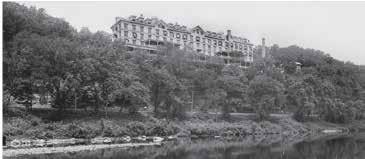
while the fathers joined them on the weekends. Visitors occupied themselves by hiking, swimming, fishing, dancing, playing tennis and golf, visiting amusement parks, shopping for souvenirs, and delighting in carriage, steamboat, and rowboat rides. According to the manager of the Kittatinny Hotel, “[p]erhaps the featuring asset of the Gap, aside from its beautiful gorge, through which shows the placid Delaware, is its health giving atmosphere, which permeates everywhere and which in itself has given the region much of its charm and popularity.”
By the early 1900s, many people had private automobiles. Magazines and newspapers extensively advertised various appealing destinations for city dwellers. At the same time, improved roads gave people a greater choice of holiday retreats. Weekend excursions began replacing summer- long holidays, and the traditional resort business of the Delaware Water Gap began to decline. The economic depression of the 1930s changed the nation’s way of life, and grand hotels could no longer compete with the new and popularly priced year-round weekend resorts in the nearby Pocono Mountains. A reclaimed the Kittatinny Hotel in 1931, and today, all that remains is the view from the location of this once grand hotel.
POINT OF GAP OVERLOOK
This overlook is in the heart of the Delaware Water Gap, between Mt. Minsi in Pennsylvania and Mt. Tammany in New Jersey. Just as it is a popular place for viewing today, this was also a popular stop for the Victorian vacationer. The Indian Head Lunch, a tourist attraction named for its view of the cliff with the same name across the river, offered meals and souvenirs, while the Myrtle William’s Gap Inn provided a place for picnicking and camping.
ARROW ISLAND OVERLOOK
Today, this overlook provides a wonderful view of the water gap and the trailhead for the Arrow Island Trail. In the early 1900s, however, this was a bustling tourist stop. Minsi Mountain Park encompassed about 200 acres, and a hotel with a few outlying cottages was located on the hill overlooking the river. Inventive owners marketed a nearby slate quarry as a romantic enticement called “the Grotto” and boasted of the clear waters found in the “Minsi Health Spring.” In the location of today’s parking area, the Bear Stop roadside attraction featured caged bears and deer for the tourists’ amusement.
22 | Guide to the Gap
Kittatinny House Hotel
WATERFALLS

RAYMONDSKILL FALLS
Raymondskill Creek Trail, Pennsylvania GPS 41.290231 -74.840853
The loop trail that leads to the waterfall is only 0.3 mile, but is steep. The three tiers of Raymondskill Falls have a combined height of approximately 150 feet, making it one of the tallest waterfall in Pennsylvania. If the drops from each tier are added together, the waterfall is only a few feet shorter than Niagara Falls. The upper viewing area overlooks the upper pool and the narrow chute of the first drop. The lower viewing area provides an outstanding view and photo opportunity of the falls. A spur trail leads to the creek, but not to the bottom of the waterfall.
Things to Know:
• Pets are not permitted on the trail.
• Swimming and wading is not permitted in the creek and waterfalls.
• Stay on the designated trail.
• Restrooms are located at the parking lot.
• The parking lot at the trailhead fills quickly on summer weekends. To avoid the crowds, visit the area before 10:00 am or after 4:00 pm on weekends or visit on a weekday.
Guide to the Gap | 23
Raymondskill Falls Courtesy of PMVB
BUTTERMILK FALLS
Buttermilk Falls Trail, New Jersey GPS 41.137164 -74.888793
The waterfall is located at the trailhead for the Buttermilk Falls Trail, and, therefore, requires no hiking to view. The cascading Buttermilk Falls is considered the highest waterfall in New Jersey at approximately 200 feet. A set of stairs climbs to a viewing platform at the top. The trail continues a nearly 1.5-mile steep climb to join the Appalachian National Scenic Trail at the top of the ridge.
Things to Know:
• Swimming and wading are not permitted in the waterfall and the pools.
• Stay on the designated trail.
• The drive to the waterfall is via a rural gravel road. Driving Mountain Road from Walpack Center is the recommended route, since Mountain Road south of Buttermilk Falls is very rough.
DINGMANS AND SILVERTHREAD FALLS
Dingmans Creek Trail, Pennsylvania GPS 41.229294 -74.887212
An accessible boardwalk trail meanders 0.3 mile through a pristine hemlock ravine. Shortly after starting the trail, Silverthread Falls gracefully drops 80 feet in a thin ribbon of water through a narrow geometric chute. The boardwalk continues through dense rhododendron shrubs and ends at the base of Dingmans Falls, the second highest waterfall in Pennsylvania at 130 feet. A wide rock ledge provides the backdrop for this cascading waterfall. The final tenth of a mile is a staircase that leads to a birds-eye view from the top.
Things to Know:
• Pets are not permitted on the trail.
• Swimming and wading is not permitted in the creek and waterfalls.
• Fishing is not permitted between Dingmans Falls and the trailhead parking area between 8:00 am and 5:00 pm.
• Restrooms and the Dingmans Falls Visitor Center are located at the trailhead.
• The parking lot fills quickly on summer weekends. To avoid the crowds, visit the area before 10:00 am or after 4:00 pm on weekends or visit on a weekday.
» Subject to change, please visit the park website or contact the park for updated information before visiting.


24 | Guide to the Gap
Buttermilk Falls
Dingmans Falls
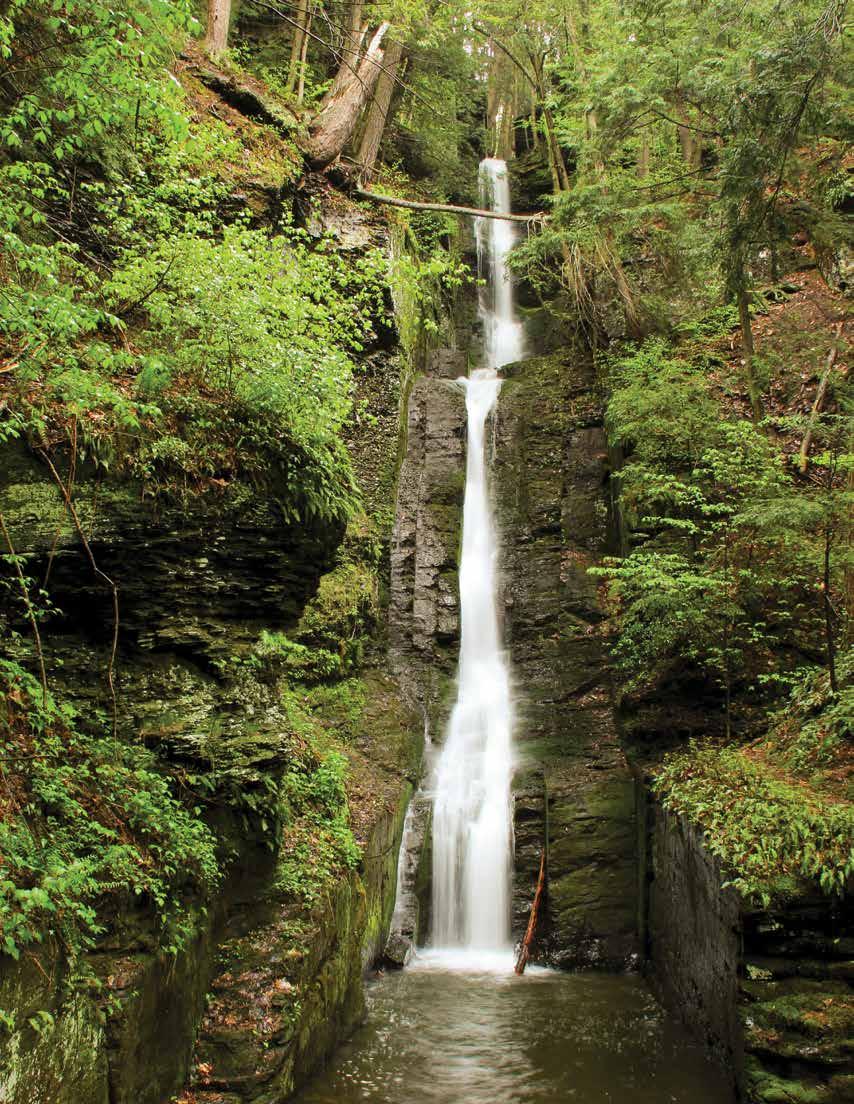
Guide to the Gap | 25
> Silverthread Falls, Dingmans Falls Boardwalk Trail
People of the Delaware River Valley
Human occupation in the Delaware River valley dates back over 12,000 years when small family bands moved across the landscape, hunting game, fishing the rivers and streams and gathering food from the forests and grasslands. About 8,000 years ago, groups began to travel less and relied on a variety of foods found locally, such as acorns, nuts, sh, deer and turkey. Families began farming about 2,000 years ago, leading to a more settled lifestyle.
The Lenape (len-AH-pay) or Delaware lived in an area they called “Lenapehoking,” which means “Land of the Lenape.” Lenapehoking included eastern Pennsylvania, all of New Jersey, southeastern New York, northern Delaware, and a small section of southeastern Connecticut. While some Lenape lived in large villages of about 200 people, most lived in groups of 50 to 75. The arrival of Europeans in the mid1500s meant drastic changes for the Lenape. European explorers traded iron axes, cloth, and copper kettles with the Lenape for valuable animal
furs. In addition to the rich natural resources, Europeans also wanted land. Conflicts arose between the Lenape and European colonists over land ownership. Additionally, the introduction of diseases devastated the native population, who had no immunities. By the mid-1700s, warfare and diseases contributed to an estimated loss of 90% of the Lenape people. During the 1700s, most Lenape people either voluntarily moved or were forcibly moved west, eventually settling in Canada, Wisconsin, and Oklahoma.
Today, most Lenape decedents still live in Canada, Wisconsin, and Oklahoma. Their arts and oral traditions reflect their culture, and they continue to stay connected to their ancestral homeland. The Lenape legacy remains, and their impact is honored through various place names in the park today.
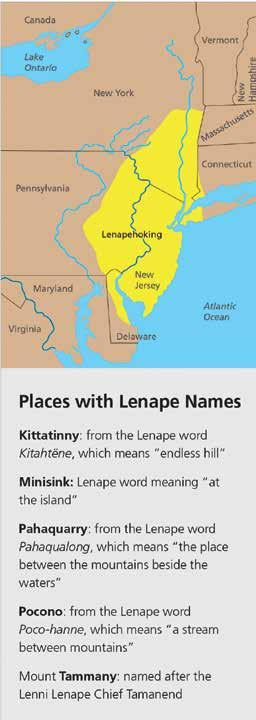
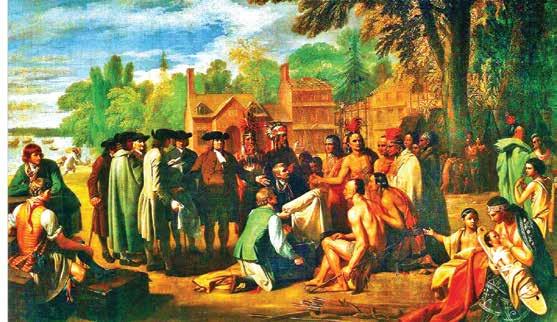

26 | Guide to the Gap
Left: Painting depicting William Penn entering into 1683 peace treaty
Right: Tish-Co-Han, Lenape Chief in the 1700s
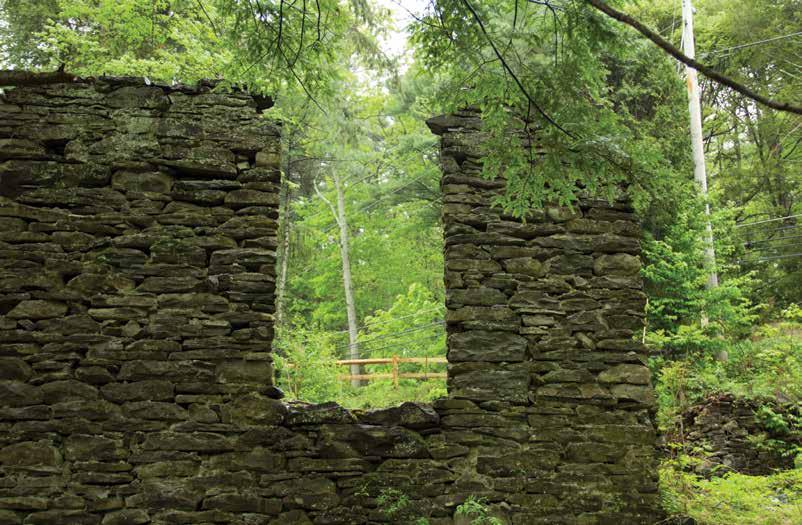

Guide to the Gap | 27 Pond at park headquarters
Woolen Mill

Delaware Water Gap National Recreation Area is a National Park Service unit that includes 40 miles of the Middle Delaware River and more than 60,000 acres along the river's banks between Milford, PA, and Delaware Water Gap, PA. The park provides outdoor recreation opportunities while conserving the natural, cultural, and scenic resources of the recreation area.
www.nps.gov/dewa | (570)
Produced by Pocono Mts. Publications, LLC In cooperation with the Delaware Water Gap National Recreation Area
426-2452
WATER AT RISK SERIES : “LIFE, LIBERTY, AND THE PURSUIT OF HAPPINESS…”
By Carol Hillestad for the Brodhead Watershed Association
America’s founding words echoed around the world — not just in 1776 but in aspiring democracies ever since. Those simple, beautiful words express a promise to everyone.
And yet…the words also contain responsibilities: those solemn promises cannot be kept when tainted air, undrinkable water, ruined soil, and vandalized forests foul our natural world.
The people of Pennsylvania recognized those responsibilities, by approving a “green amendment” to our state constitution more than 50 years ago. The voters declared that “The people have a right to clean air, pure water, and to the preservation of the natural, scenic, historic and esthetic values of the environment.”
The vote wasn’t even close. It was approved by a four-toone margin, despite opposition from the coal/steel/railroad and other industries. And it took many years before state court decisions caught up to the will of the people.
Industries, warehouses, and even some private citizens still push back, declaring that their right to use their land however they choose supersedes our human right to clean water.

JUNE/JULY 2024 POCONO LIVING MAGAZINE© 19




Volunteer organizations like Brodhead Watershed Association and Pocono Heritage Land Trust stand up for the environment every day — but there’s only so much they can do.
“And yet…the words also contain responsibilities: those solemn promises cannot be kept when tainted air, undrinkable water, ruined soil, and vandalized forests foul our natural world.”
County conservation districts and your local municipality’s land use ordinances are the essential front line. Their regulations and enforcement are what make Pennsylvania’s green amendment work in our own backyard.
Just as important, it’s you and your voice that keep local officials focused on your right to clean air, pure water, and a livable world for you, your kids, and generations to come. Be true to the promises of life, liberty and the pursuit of happiness — be a champion for a clean, livable world. And happy Earth Day!
About the work of defending our right to clean air and water: https://www.delawareriverkeeper.org/ongoing-issues/ pennsylvanias-green-amendment-generations
20 POCONO LIVING MAGAZINE © JUNE/JULY 2024

Before the Green Amendment to the state constitution, many creeks in Pennsylvania ran orange with acid mine drainage, a legacy of the coal industry. According to conservationadvocate. org, the joke was that if you fell into one of them, “you didn’t need to worry about drowning. You would dissolve first.”
Efforts are underway around the country, but currently Pennsylvania is one of only four states that have green amendments. The others are Montana, Massachusetts, and, most recently, New York.
Brodhead Watershed Association protects water quality and quantity throughout our area. Get involved! Become a member! www.brodheadwatershed.org
Brodhead Watershed Association is a nonprofit environmental organization formed in 1989. BWA is dedicated to protecting and preserving water resources and the environment of the Brodhead watershed, and the water quality of the Brodhead, Cherry, Marshalls, McMichael, Paradise and Pocono creeks and their tributaries. BWA assists municipalities, residents, businesses and groups with protecting natural resources through education, workshops, seminars, public programs and stream monitoring. For information: info@brodheadwatershed.org or 570-839-1120.
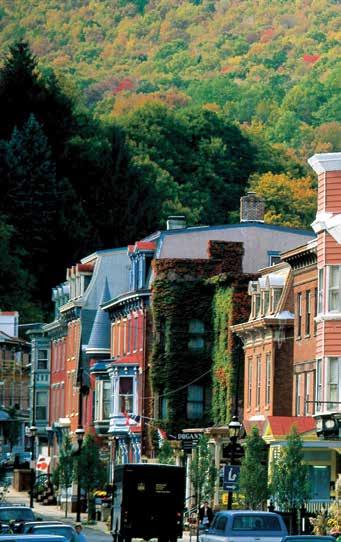


It’s not just a day of shopping here in the Pocono Mountains—it’s an experience. Wander our historic streets. Explore our art galleries. Find unique local goods. And stop for a bite at one of our top-rated neighborhood restaurants along the way. Discover all of our shopping and sights now at PoconoMountains.com.
SHOP NEW. SHOP VINTAGE. SHOP LOCAL.
Photo courtesy of Pexels.com/Matthew Montrone
JUNE/JULY 2024 POCONO LIVING MAGAZINE© 21
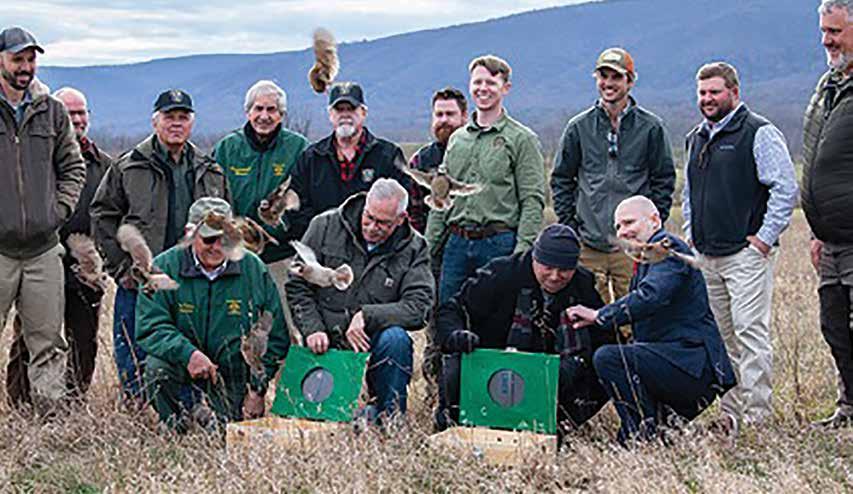
BOBWHITE QUAIL REENTER KEYSTONE STATE AFTER OVER 25 YEARS
Courtesy of NWTF
The NWTF is a proud partner in a multi-year habitat project that is the headspring of quail restoration in Pennsylvania. The project serves as a bright reminder that the NWTF's work for wild turkeys benefits entire ecosystem health.
Once found in all 67 Pennsylvania counties, the northern bobwhite quail population dwindled to zero in the state by the late 1990s or early 2000s. That is, until recently, when Pennsylvania Game Commission staff and partners translocated dozens of wild northern bobwhite quail from Florida, Kentucky and Virginia as part of an aggressive effort to reestablish a reproducing population of birds within the boundaries of the Keystone State.
After a 2014 PGC survey confirmed that there were, indeed, no wild quail within the commonwealth's boundaries, discussions began about what a restoration plan would look like.
It was determined that the 18,000-acre Letterkenny Army Depot – with its minimally accessed land, historical grassland habitat and talented land managers – would serve as the starting point for quail restoration for the whole state.
The seconds it took quail to fly out of a few transport boxes into their new home was made possible by years of prior intensive habitat management and diligent planning among a variety of stakeholders.
22 POCONO LIVING MAGAZINE © JUNE/JULY 2024
“It's been a lot of hard work,” said Matt Miller, natural resources manager at the Letterkenny Army Depot. It has been very rewarding to see the benefits to our native habitats and our wildlife species here on the depot.”
“In 2017, the partnership began between us and the game commission to start habitat work…which was transitioning undesirable and non-native tree and shrub species to grasslands and early successional habitats.”
The NWTF proudly partnered on the project by acquiring a $100,000 Monarch Butterfly and Pollinators Conservation Fund grant from the National Fish and Wildlife Foundation.
“Thank you to NWTF, who provided at least $110,000 worth of grants to the project converting agricultural fields into pollinator fields,” Andrew Ward, PGC quail, pheasant and dove biologist, said at the quail release ceremony. “Again, this project helping a wide variety of species beyond bobwhite, although bobwhite is our primary focus today.”
“Once found in all 67 Pennsylvania counties, the northern bobwhite quail population dwindled to zero in the state by the late 1990s or early 2000s.”
NWTF District Biologist Mitchell Blake, who wrote the Monarch Butterfly and Pollinators Conservation Fund NFWF grant application, saw it as an opportunity to benefit many species in one umbrella project.
The grant enabled the NWTF to purchase nearly $70,000 worth of a diverse pollinator seed mixture made up of 23 perennial forbs, including two different species of milkweed. In total, Letterkenny staff and partners were able to plant over 1000 pounds of pure live seed across 210 acres, enhancing the habitat diversity of the site and providing critical habitat to several imperiled lepidoptera species.
In addition to the array of pollinators and quail that will call the Letterkenny home, wild turkeys are also reaping the rewards, as indicated by the turkeys seen on the way to and from the quail release site.
The pollinator mix is getting better over time and offers essential cover and insect forage for brooding wild turkey poults and








JUNE/JULY 2024 POCONO LIVING MAGAZINE© 23 D Clothing and Jewelry from Frank Lyman • Tribal Brighton • Liverpool Jeans And Others 585 Main Street • Stroudsburg PA • 570-421-7950 585 Main Street Stroudsburg PA 570-421-7950 1471 Rt. 209 Brodheadsville PA 570-992-3865 Hunting Fishing Camping Bowhunting ... EVERYTHING!





hens, as well as providing abundant nectar sources for migrating monarch butterflies and other lepidoptera species. The pollinator mixture will also offer the translocated quail aerial protection and ample seed forage.
Learn more about how the NWTF's NFWF grant helped revitalize habitat on the Letterkenny Army Depot.
In addition to the NWTF's involvement, other nongovernmental organizations joined in to help, including Pheasants Forever and Quail Forever. Quail Forever hired dedicated habitat specialists who helped with the on-the-ground restoration work over the past several years, and the local Pheasants Forever Cumberland Valley Chapter provided significant support.

Researchers at the University of Delaware fitted quail released at Letterkenny with a leg band and a smaller group of birds with telemetry backpacks, as part of a UD project studying the birds' survival, habitat use, nesting success and movement.
“From the reintroduction of northern bobwhite quail to the turkeys seen in close proximity, last week was a success for
24 POCONO LIVING MAGAZINE © JUNE/JULY 2024 CAR & TRUCK REPAIRS • PA STATE INSPECTION LICENSE PLATES • TITLE TRANSFERS ACE TRUCKING & REPAIRS, INC. 316 CLAY AVENUE STROUDSBURG, PA (570) 421-2704 Stroud Television & Appliances 219 N. 9th Street Stroudsburg, PA 570-421-7700 www.StroudTVandAppliances.com Specializing in all your landscaping & gardening needs. Also visit our shop for unique gifts & home decor. 570.595.9760 • rossandrossnursery.com 5801 Paradise Valley Rd. Cresco, PA Since 1932 NURSERY

wildlife in the Keystone State,” Blake said. “The NWTF is proud to partner on a project that so vividly illustrates how our work to conserve wild turkeys has such far-reaching benefits for entire ecosystems.”
About the National Wild Turkey Federation
Since 1973, the National Wild Turkey Federation has invested over half a billion dollars into wildlife conservation and has positively impacted over 23 million acres of critical wildlife habitat. The NWTF has also invested over $9 million into wild turkey research to guide the management of the wild turkey population and to ensure sustainable populations into perpetuity. The organization continues to deliver its mission by working across boundaries on a landscape scale through its Four Shared Values: clean and abundant water, healthy forests and wildlife habitat, resilient communities, and robust recreational opportunities. With the help of its dedicated members, partners and staff, the NWTF continues its work to provide Healthy Habitats. and Healthy Harvests. for future generations.


JUNE/JULY 2024 POCONO LIVING MAGAZINE© 25 The AGENCY Because the world keeps turning Insurance since 1942 Serving the Poconos for over 70 years CHOOSE DREHER BECAUSE WE CARE! BUSINESS & PERSONAL INSURANCE Theodore G. Butz, CPCU 551 Main Street, Stroudsburg, PA 18360 570-421-6141 www.dreherinsurance.com
of Pexels.com/Brett Sayles
Photo courtesy
HOW TO SUPPORT YOUR PET’S HEALTH DURING SUMMER
Courtesy of Family Features

As a pet parent, you know your pet's needs are continually evolving. That's true during different stages of growth and even as the seasons change.
Part of supporting your pet throughout the year is understanding the specific risks that come with changing weather and special seasonal events. Supporting pets this summer can be easier with these tips:
Summer Health Concerns
It may be an exciting time of year for humans with all the extra activities, seasonal celebrations and travel, but those summer pastimes can add up to a whole lot of stress for pets. In addition, environmental factors like allergens and heat can affect them more than you realize.
* Allergies: Pets can be affected by many of the same allergens as humans, including grass, pollen and other vegetation that is more prevalent during warmer months. Watch for signs of trouble such as scratching, chewing, watery eyes and general
discomfort. Veterinarians can offer advice on allergy support and supplements appropriate for your pet's age, breed and size.
* Fireworks: Summer tends to bring more loud noise and commotion in general, but this is especially true around the Fourth of July when explosions become the norm. If pets are fearful, it's especially important to ensure they stay in wellsecured areas since fireworks are a common cause of pets running away. If possible, find a safe spot within your house where outside noises are muffled. Provide some comfort items and check on them regularly. If they seem extremely distressed, vet-recommended anxiety treatments and supplements can help promote relaxation and soothe their nerves.
* Travel: If your pet suffers from separation anxiety, summer trips can be especially problematic. One solution is to take your pet with you, but that's not always practical or even possible. When pets with separation anxiety stay behind, it's a good idea to leave them with someone they know, and even better
26 POCONO LIVING MAGAZINE © JUNE/JULY 2024
of Shutterstock
Photo
courtesy
if that person can stay in your home so pets are in familiar surroundings. If that's not an option, introducing pets to their caretaker or doing a trial run at the kennel can help ease their nerves. In extreme cases, you may need to consult with a vet about supplements that can help soothe pets in your absence.
* Dehydration: Just like humans, hotter temperatures make it easier to get dehydrated, which can lead to myriad health concerns. Ensure pets have access to fresh, clean and cool water at all times and be sure to alert your veterinarian if you notice any changes in their interest in drinking, as that can signal an issue. Also watch for signs of dehydration, such as weakness, less energy, changes in appetite and panting.
Managing Activity Levels
During the summer months, pets may be tempted to take it easy in the heat, or you may have the opposite problem: a pet that's a little too active for the elements. Monitoring the ir activity level is important to ensure they don't get overheated but also get adequate exercise to maintain a healthy weight and keep muscle tone strong. This may require getting creative about bringing playtime indoors or shifting your routine to accommodate walks early or late in the day when temperatures tend to be more forgiving.
Introducing Health Supplements
Monitoring pets' health isn't a one-size-fits-all effort. In fact, different breeds have distinct needs when it comes to exercise, behavioral training and even nutrition. Supplements, from multifunctional solutions to those targeting specific issues, can help complement regular food to ensure pets are getting all of the nutrients and preventative support they need to thrive. One comprehensive option is NaturVet's Breed Specific Soft Chews supplement line, which is made up of five products that provide proactive support for distinct dog breed categories, including toy/small, bully, sport/working, doodle and giant.
The vet-formulated soft chew line was designed to offer a streamlined and personalized supplement approach for breeds with particular health needs. To support pets precisely as they are, each product offering is formulated for pure and mixed breed dogs alike, delivering tailored, wholesome ingredients to address joint, allergy, immune, heart, gut, anxiety and dental issues.
Find more advice for supporting your pet's health this summer and beyond at naturvet.com.




JUNE/JULY 2024 POCONO LIVING MAGAZINE© 27 Located at Stroudsburg Cemetery on Dreher Avenue 570-420-9599www.CreeksidePet.net / 570-421-4501 Compassionate Care That Lasts Forever Creekside PET CREMATORY www.CreeksidePet.net www.farmers-basket.com Top CropsPRODUCE Naturally Grown Vegetables & Herbs Hydroponic Lettuces Home Made Jams, Jellies, Pickles & Relishes Dried Fruit, Herbs & Herb Blends Home Made Pies, Cheese Cakes & Bread Potted Perennials & Cut Flowers Cheryl & Rich Witby (570) 460-1452 Visit us at the Farmer’s Market!
Lawn & Garden BILLY’S TIPS

What’s the peskiest part about the summer? You guessed it - insects! But, believe it or not, a little landscaping and maintenance can be the key to a pest-free home.
• Standing water is a breeding ground for flying insects, like mosquitoes. Check for leaky outdoor faucets and objects, like buckets, that collect water. For items that have to stay outside, flip them over or cover them with a tarp. By eliminating areas of still water, you’ll reduce the number of places for mosquitoes to lay their eggs.
• Apply a preventative grub control product early to stop grubs from taking over your yard. If you’ve already spotted grubs in your lawn, you’ll need corrective grub control instead. Grubs typically hatch in late-summer, so eliminate them while you still can.
• Mulch does wonders for your property...and for your pests. Insects, such as spiders and ants, love to make their homes in beds of warm, moist mulch. If you can’t say no to mulch, at least keep it a safe distance from your house and spread it no more than a few inches thick. You can also use a gravel border to create a separation between your house and mulch.
• Keep your lawn cut short to reduce places for creepy critters to hide. And always remember to stay on top of weeding and gutter maintenance. All of these places make optimal hideouts for insects.
• Opt for an organic insecticide to rid yourself of pests the natural way. Do-it-yourself recipes, like oil soap sprays, can control mites and beetles without harming your plants or your family. Introducing certain plants, like mint, into your garden can even ward off aphids. Check out Rodale’s OrganicLife online for some clever, natural tips and tricks!
Canfield’s Pet & Farm
315 Main Street, Stroudsburg, PA 570-421-1821
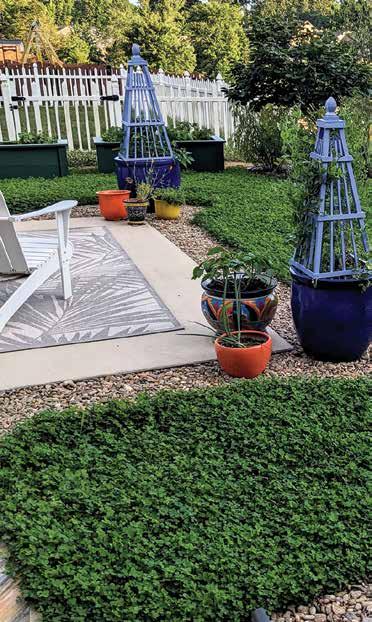
GONE VIRAL
‘MINICLOVER’ IS A TOP TRENDING GRASS
ALTERNATIVE
FOR YARDS ACROSS AMERICA
By Joan Casanova
I
f you're looking to renovate your yard, there's a sustainable, drought-tolerant alternative to highmaintenance, water-guzzling grass that also reduces your environmental footprint.
"Clover lawns" went viral on social media last fall and became the most searched home improvement trend on

Google in 2023. If you search #cloverlawns on Tik Tok, viewed more than 150 million times, you'll be bombarded with photos and videos of fluffy, lush, green, gorgeous lawns grown with Miniclover seeds.
"'Miniclover' (Trifolium repens) is about 1/3-1/2 the size of white Dutch clover, only grows 4-6 inches and produces a thick, carpet-like look that blends well with turf," said Troy Hake, president and owner of Outsidepride.com, offering drought-tolerant grasses, clovers, wildflower seeds and more. "It's less expensive than grass seed and a natural solution for self-sustaining, low-maintenance lawns that look beautiful and help eliminate the need for fertilizers, herbicides, pesticides and weekly mowing. We sold out of it for the past two years, even with a two-fold increase in production. You can't go wrong with it."
Wondering why grass gets a bad rap? The truth is climate change is looming and has further altered the natural pattern

JUNE/JULY 2024 POCONO LIVING MAGAZINE© 29 Schisler Museum of Wildlife & Natural Histor y McMunn Planet arium East Stroudsburg University of Pennsylvania Experience wildlife exhibits and sky shows for explorers of all ages! East Stroudsburg University Hoeffner Science & Technology Center 108 Normal Street East Stroudsburg, PA 18301 570-422-2705 esu.edu/museum
Photo courtesy of OutsidePride.com




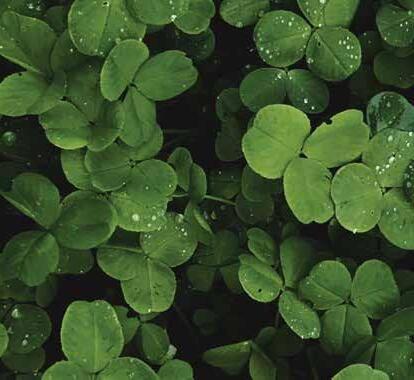
“For homeowners looking to reclaim weekends and minimize time and effort spent on lawn care, Miniclover seems like a dream.”
of droughts, making them more frequent, longer and more severe. Grass lawns, however, are not sustainable; they're the most maintenance-intense part of yards, requiring regular fertilization, mowing and heavy irrigation to look good. Nationwide, landscape irrigation is estimated at almost 1/3 of all residential water use, totaling nearly 9 billion gallons per day. Plus, gas-powered lawn and gardening equipment release more than 30 million tons of carbon emissions, according to the U.S. Environmental Protection Agency's National Emissions Inventory.
In some regions, there's continuous, strict regulations on watering lawns or bans on the use of drinking water for irrigating grass. As concerns about climate change and water scarcity intensify, some homeowners are looking for landscaping solutions that minimize water usage and reduce environmental impact. A standout in this regard, Miniclover requires significantly less water than traditional grass to thrive. It's drought-tolerant and has longer, deeper roots than grass, reaching into the soil for needed moisture, requiring minimal watering, staying greener longer and showing more resiliency during periods of drought or water restrictions.
It takes nitrogen from the air, "fixing" it in the soil and eliminating the need for fertilizer or nitrogen plant food because it does the work for you, keeping grass green and growing while adding natural nitrogen to surrounding soil.
Some homeowners are already tearing up grass and completely replacing it with Miniclover; others are overseeding existing grass, reaping the many benefits of clover while maintaining
30 POCONO LIVING MAGAZINE © JUNE/JULY 2024
Let us create something beautiful for you EXQUISITE FLORAL • GIFTS • HOME DECOR (570)424-1174 931 Ann Street • Stroudsburg, PA 18360
THE POTTING SHED
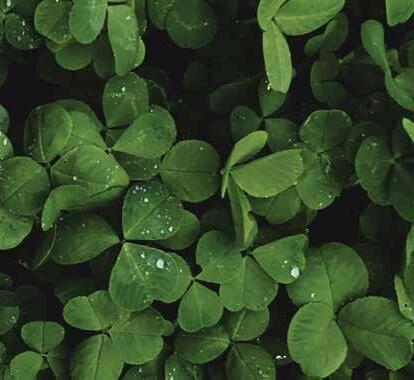
a lawn-like look without committing to a complete lawn replacement. Both options are more sustainable and environmentally friendly than grass lawns.
With hectic lifestyles the norm, many homeowners want landscaping solutions that require minimal upkeep. While grass lawns require constant mowing, watering and fertilizing, perhaps it's time to grow something other than traditional turf. Miniclover's slow growth habits mean less time behind the mower while its dense growth pattern, evenly dispersed via stolons (stems that grow horizontally along the ground), crowds out weeds and controls erosion.
No need for herbicides; they'll kill it. Grubs won't eat it and bugs won't lay eggs in it. It stands up to compacted soil, plus it's immune to "dog patches." It fills in bare spots fast and tolerates wet conditions. Mow as little as you like - the more it's cut, the smaller the leaf size - or simply let it grow close to the ground, like grass. It blooms only once in summer with small, delicate flowers, which provide bees with nectar or, if preferred, mowing prevents blooming. It withstands foot traffic, making it ideal for pathways and play areas and its tolerance for shade makes it suitable for areas with limited sunlight.
For homeowners looking to reclaim weekends and minimize time and effort spent on lawn care, Miniclover seems like a dream. It lives up to its hype, offering the winning combination of environmental sustainability, very low maintenance, drought tolerance, aesthetic appeal and cost efficiency that benefits not only homeowners' properties, but planet Earth as well.
For more drought-tolerant options, visit Outsidepride.com.


















JUNE/JULY 2024 POCONO LIVING MAGAZINE© 31 925 Ann Street • Stroudsburg, PA 18360 (570) 421-7470 • www.americanribbon.com Discover Stroudsburg’s best kept secret, tucked away on Ann St. Find us on:
• Cra s •
•
Manufacturing, Inc. Stroudsburg, PA (570) 620-1880 cookscornerrestaurant.com 3150 Rt. 715, Henryville, PA 18332 Casual Dining In A Friendly Atmosphere Wednesday - Saturday • 11am-8pm | Sunday • 8am-8pm | Closed Monday & Tuesday
Unique Gi s • Decor • Flags Ribbon
Fabrics
Trophies
OPEN FOR DINE IN OR TAKE OUT
Photo courtesy of Pexels.com



Bob Hay


Trusted Real Estate Advisor
Cell: (570) 656-2471
Office: (570) 421-2890 x5025
bob@bobhay.com
www.BobHay.com

404 Park Avenue •Stroudsburg, PA 18360
POCONO REAL ESTATE PULSE
By Bob Hay
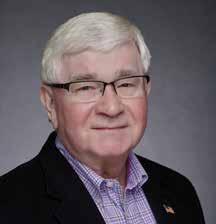
SETTING THE RECORD STRAIGHT ON REAL ESTATE COMMISSIONS
On March 14th the National Association of Realtors (NAR) announced a proposed settlement agreement that would end litigation of claims brought on behalf of home sellers related to broker commissions. There have been a lot of news reports on mainstream and social media that are either misinformation or disinformation.
The results of this settlement, if approved by the court, will not begin to take effect until mid to late summer at the earliest. Time is needed for the proper disclosures, forms and guidelines to be developed and implemented by the members of NAR.
“There is no doubt agents will have to make changes in the way they do business.”

Here are a few clarifications that were misrepresented:
Broker commissions have never been set or suggested by the NAR, state and local associations or Multiple Listing Services (MLS).
Commissions have always been negotiable between Brokers, There have always been various business models that brokers offer to consumers depending on what they feel is best for them such as: Full service brokerage, limited services brokerage, discount brokerages and MLS entry only. And they always have the choice of doing For Sale by Owner (FSBO).
A few key changes are coming that will affect Realtors and consumers.
• No offer of co-broke compensation can be published in the MLS.
• A buyer must sign a Buyer agency agreement before a Realtor can show them a house.
32 POCONO LIVING MAGAZINE © JUNE/JULY 2024
courtesy of Pexels.com
Photo
• Buyers can be subject to paying their agents fee which could mean they can not afford to buy.
There is no doubt agents will have to make changes in the way they do business.
Pennsylvania Realtors are out in front of a lot of these changes. Buyer agency… Act 112 creating buyer representation was passed by the state legislature in 1998 and went into effect in 1999. We have been having Buyers sign agency contracts for 25 years!
Our listing contract has disclosed the fee that would be paid to the buyer’s agent on their behalf for years.
Brokers and agents will receive ample education prior to these changes becoming effective. Be prepared to have discussions with your Realtor prior to signing a listing or buyer agency agreement.
ABOUT THE WRITER
Bob is a lifelong resident of the Pocono Mountains and has been in the real estate business for over 45 years. He is a Trusted Real Estate Advisor to buyers, sellers, other agents and brokers. He specializes in residential and investment properties.
Bob is a mentor to other agents and regularly conducts contracts classes for new and experienced agents. He is a past president of the Pennsylvania Association of Realtors where he has received numerous awards.
He is considered a community leader where he serves as Chairman of the Pennsylvania Northeast Regional Railroad Authority, Vice-Chairman of the Pocono Mountain Economic Development Corp. and a Board Member of the Pocono Chamber of Commerce. A past Chief of the Pocono Mountain Volunteer Fire Company and is a Vietnam War Veteran.
Bob lives in Mount Pocono and enjoys classic cars, photography, birding and road trips.



JUNE/JULY 2024 POCONO LIVING MAGAZINE© 33 P&S GARAGE Servicing the Poconos since 1975 Scott Dreisbach owner 570-223-8874 9080 Franklin Hill Road East Stroudsburg, Pa www.psgaragepa.com PoconoFourWheelDrive.com
Barrett
Cresco, PA
570-595-7171 www.barrettlibrary.org
Clymer Library Pocono Pines, PA
570-646-0826 www.clymerlibrary.org

Pocono

PA
PA


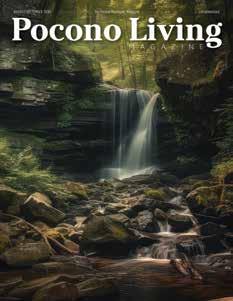
34 POCONO LIVING MAGAZINE © JUNE/JULY 2024 Next Issue of Pocono Living Magazine Available at Local Businesses & by Subscription Pocono Magazines, LLC 1929 North Fifth Street, Stroudsburg, PA 18360 570-424-1000 • pmags@ptd.net
Paradise Friendly Library
Mountain
Monroe Public Library Branches Hughes Library
YouMayAlsoEnjoy Pocono Family Magazine
courtesy of Pexels.com
Public Library Tobyhanna,
570-894-8860 www.poconomountpl.org Western Pocono Community Library Brodheadsville,
570-992-7934 www.wpcl.lib.pa.us Eastern
(main branch) Stroudsburg, PA 570-421-0800 www.monroepl.org Pocono Township Branch Tannersville, PA 570-629-5858 Smithfield Branch Marshalls Creek, PA 570-223-1881 Bookmobile 570-421-0880 x49
Photo















JUNE/JULY 2024 POCONO LIVING MAGAZINE© 35 CALL 570-421-2100 FOR MORE INFORMATION ON ADVERTISING WITH US! DISPLAY ADS ONLINE AUDIO FACEBOOK & INSTAGRAM TARGETING LIVE CHAT NATIVE ADS SEO & REP. MANAGEMENT VIDEO PRE-ROLL MOBILE CONQUESTING OTT PAY PER CLICK AMAZON PREMIUM SOCIAL MIRROR GEO-FRAMING LINKEDIN ADS RADIO • DIGITAL • RECRUITMENT Live, Local Radio
Leading the Poconos in surgical excellence.
Bogdan Protyniak, MD
Colon and rectal surgery

When you need surgery, excellence matters. At Lehigh Valley Hospital–Pocono, you get the compassionate, leading-edge care you deserve. And being part of LVHN’s Institute for Surgical Excellence provides you access to the latest technology, including robotic-assisted surgery. This means a quicker recovery and better results. Experience matters. The more you do, the better you are, and the faster we get you back to being you. LVHN.org/surgery | 888-402-LVHN


































































































































































